Jack Brabham. After Nuvolari, before Senna. When F1 was not yet a circus but a gym for motors and the Beatles four friends at the bar. 20 May 2014.
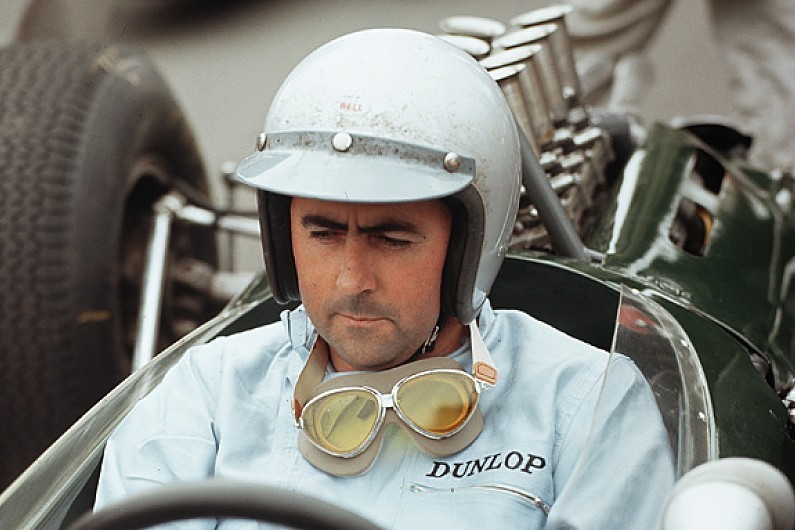
Brabham was a unique character in the world of motorsport. Formidable driver, of cars, but also of planes, his true dream as a child.
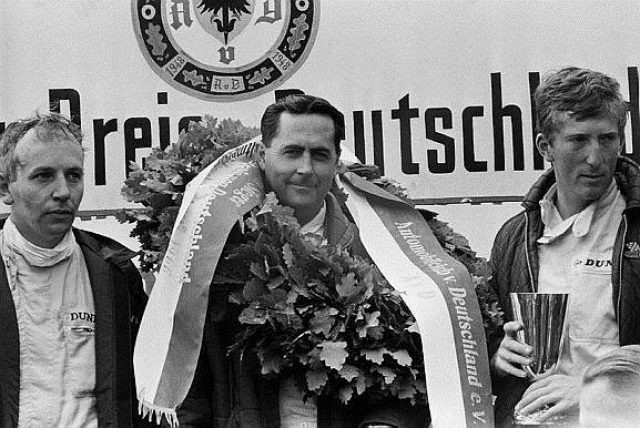
John Surtees, Jack Brabham and Jochen Rindt.
He had everything to go down in history, as his illustrious beaten opponents, Moss, McLaren and Surtees knew well. But no one in the cemetery of the crazies behind the wheel will be able to boast himself of having done everything by himself, defeating his dues and the help of the others (he brought home the first two World Championships with Cooper, who, however, made him buy the first car and, as technical support, only gave him the keys to the truck to bring the necessary, including the car, to the Grands Prix) with his own ingenuity, with the creation of his own team, in 1962 and with a brand, Brabham, which he sold to a partner in 1970, but which continued to racing until 1992, making other drivers and many fans and enthusiasts dream.
When a grocer's son could still go from making deliveries in the pickup truck to crossing the finish line on a track. When not only the imagination went to power, but also the know-how, the manual skills, when you were building dreams by yourself, with the grease of the oil, by force of elbows, swapping paint with those who wanted to snatch success from you. The art of getting by was really hard, you could hear the wind, there were still no full-face helmets and the thunder of the pioneering engines boomed in your ears. A difficult and wonderful era, which goes away with Jack.
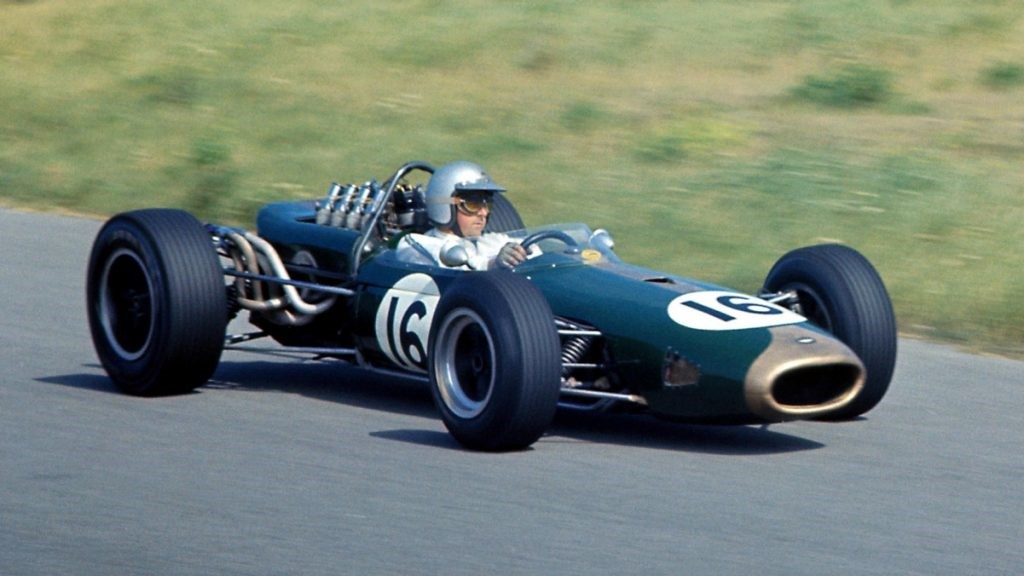
Brabham, Australian, the grandson of English emigrants, born in a suburb of Sydney and son of the difficult post-war period of the First World War, a teenager when the world was again immersed in a second devastating war period, has always known the art of getting by and this way of being, combined with great inventiveness, has allowed him to emerge in a four-wheeled universe full of extravagant pioneers, but also of unscrupulous rich people. He has always been distrustful, with his menacing silences. A rough temper, he never liked to talk. He preferred to act, to work in the workshop, to fight with rivals on the track, to win. He was not an easy guy.
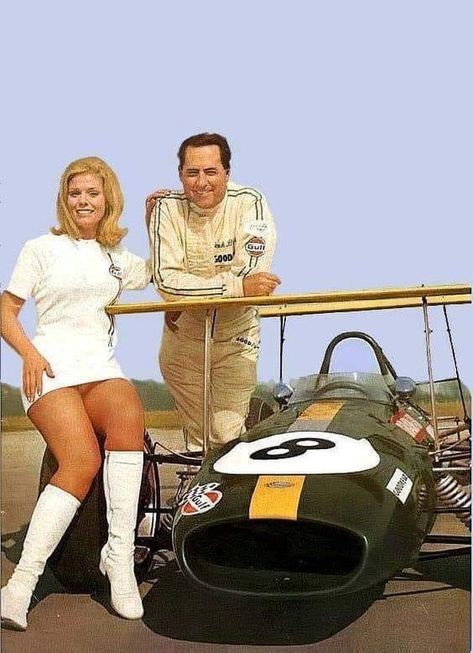
Jack Brabham with his Repco Brabham and a girl.
In 1967, three years before his retirement, he had already won three World Cups, was over forty and, with his Brabham, was aiming for a poker. The title went to his teammate Hulme. He was racing for his squad, dared to challenge him, beat him, doing him this terrible discourtesy. After so much glory he could have accepted his fate and, instead, he will remember this: he summoned Hulme, did not compliment him and chased him away.
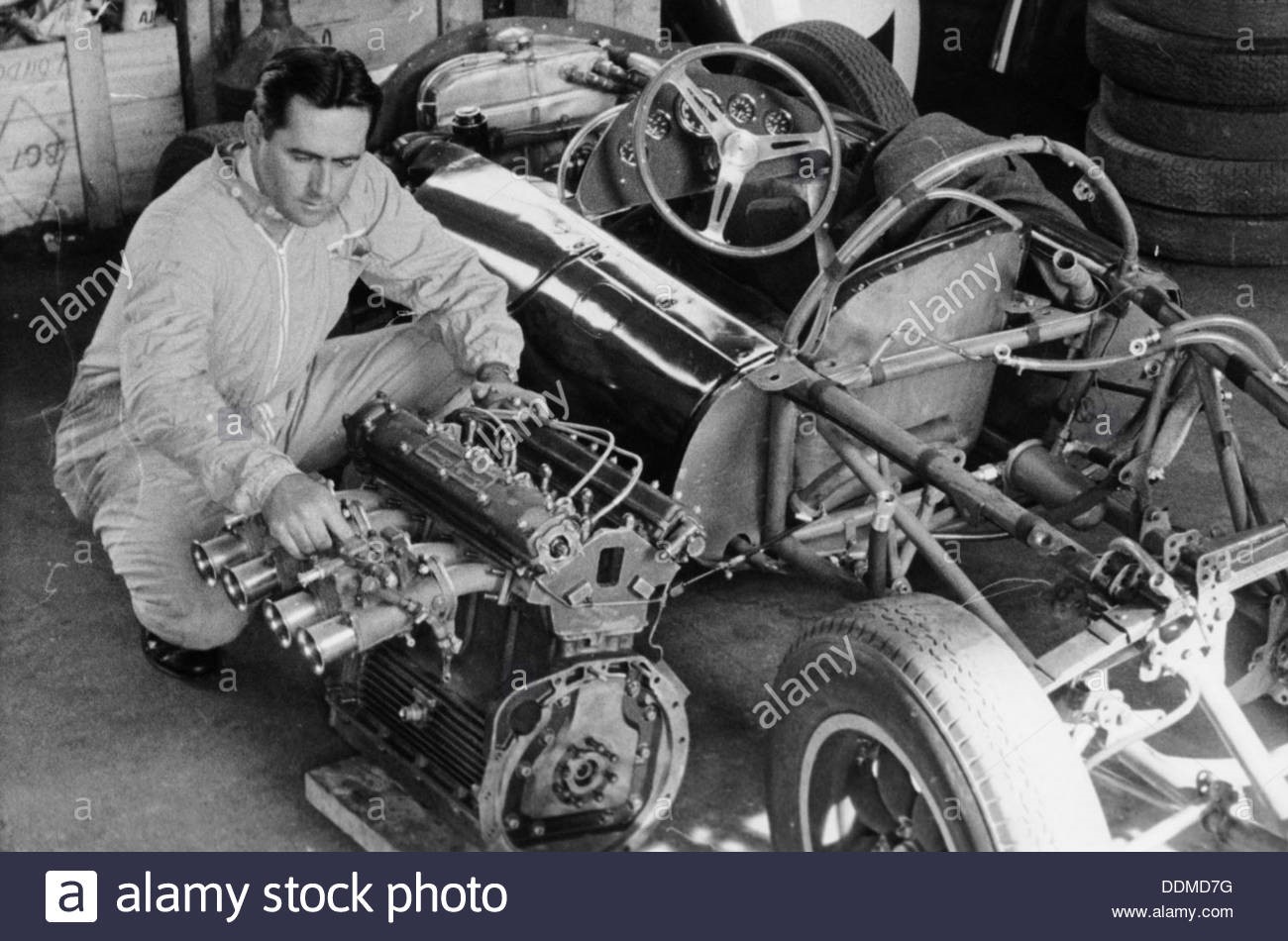
A pilot, test driver, builder. "Made by myself". Maybe that's why he didn't crash cars, he knew what was behind them and also inside. And how to make them go fast in corners. He had been practicing when he was 12, on the rough roads outside Sydney, with Dad's truck he brought the goods home, even though he didn't have a driver's license yet. Three years in the Royal Australian Air Force had strengthened his passion for flying and speed. He spoke little, indeed nothing. He looked hostile. He was best explaining himself with the clutch. No school, his sensitivity was for cylinders and pistons. Brabham moved to Europe and made his debut in Formula One. His slogan: "I'm the nurse of my car, I know its limits and I don't go beyond them." In 1959, in a Cooper Climax, he won in Monaco and was awarded by Princess Grace. His rival Phil Hill said of Jack: "we hated him, he never gave up, he didn't socialize, he was only interested in winning." Stirling Moss confirmed: "he didn't drive dirty, but you never took him off, not even if you overtook him." Yeah, he didn't like being blacked out. "I started on the bumpy climbs of my country, I'm certainly not a gentleman who looks after the cleanliness of style." In 1960 another triumph for Jack. In '61 he decided to do everything himself in Australia: engine, design, driving. More than Enzo Ferrari and without being an engineer. And, in 1966, he became the first driver to win with "his" car. The BT19. He also wins the constructors' championship. With the first naturally aspirated turbo engine that will have a long life. In '79, when the Lotus seems unbeatable, Gordon Murray tells Niki Lauda that nothing goes faster than the Brabham BT46B, which was then removed from the pact and compromise between Bernie Ecclestone - who was at the head of the team until 1987 - and the French Jean-Marie Balestre, the authoritarian president of FISA.
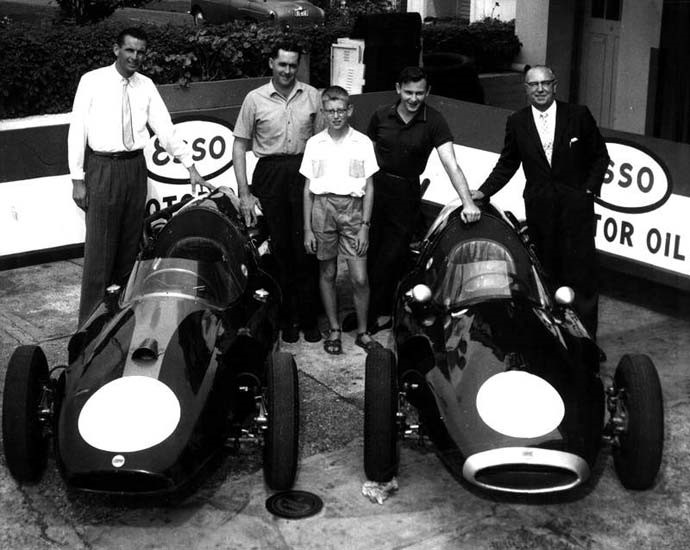
Bruce McLaren and Jack Brabham.
Jack is gone, he left the scene in '70, also because his friend and rival Bruce McLaren died in an accident on track. "I lost more than 30 colleagues, it hurt a lot to lose Bruce, in those days the cars were fragile". Jack lived in England and wintered in Australia in the winter. He said it was useless to tell lies: "the only thing that matters is when you see the flag waving on arrival, the rest is nonsense."
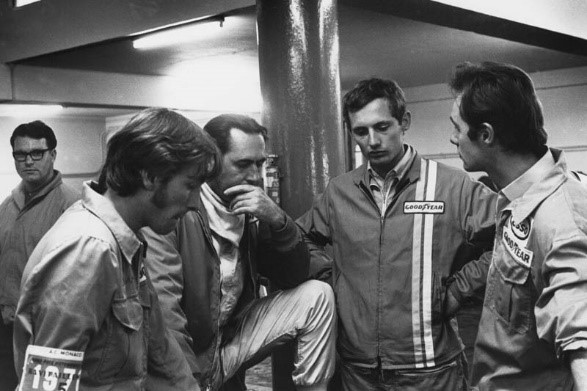
McLaren boss Ron Dennis, who worked with Jack Brabham at his eponymous outfit, has paid tribute to the legendary Australian. Here in the photo Jack and Ron in 1970.
Ron Dennis pays tribute to Sir Jack Brabham. Posted on Monday, 19 May 2014.
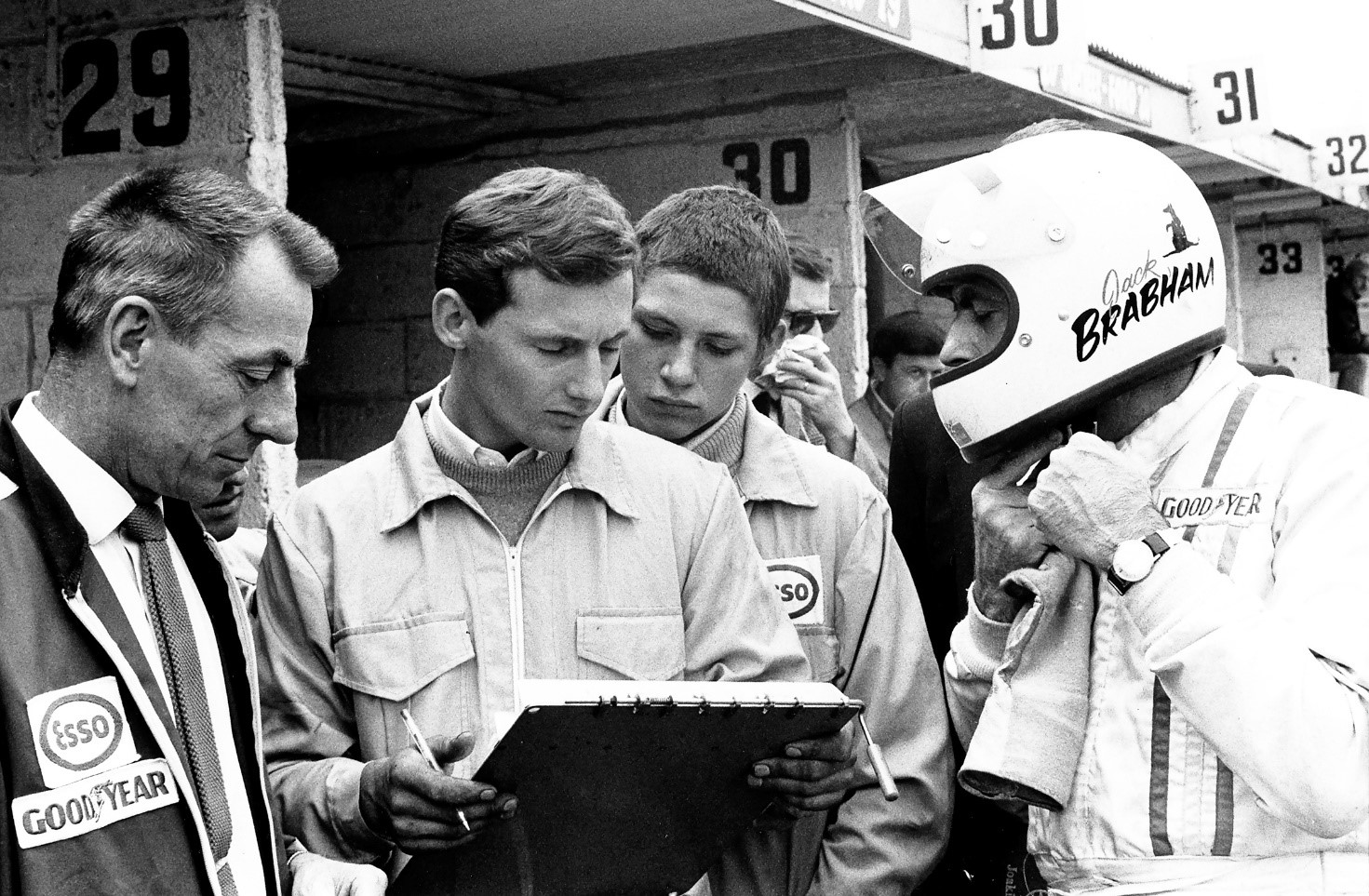
Ron Dennis briefing Jack Brabham, Brands Hatch 1970. Photo by Getty Images.
Everybody at McLaren is deeply saddened to learn of the passing of Sir Jack Brabham. Below follows the thoughts of McLaren Group Chairman and CEO, Ron Dennis: "the word 'legend' is often used to describe successful sportsmen, but often it exaggerates their status. In the case of Sir Jack Brabham, however, it's entirely justified.
"A three-time Formula 1 world champion, he remains the only driver to win a Formula 1 world championship driving a car bearing his own name - a unique achievement that will surely never be matched.
"When I started out in Formula 1 in the late 1960s, I worked first for Cooper and then for Brabham. Even as a callow youth, I could recognise greatness when I saw it and I'll always regard it as an honour and a privilege to have worked for Sir Jack. I learned a lot from him too.
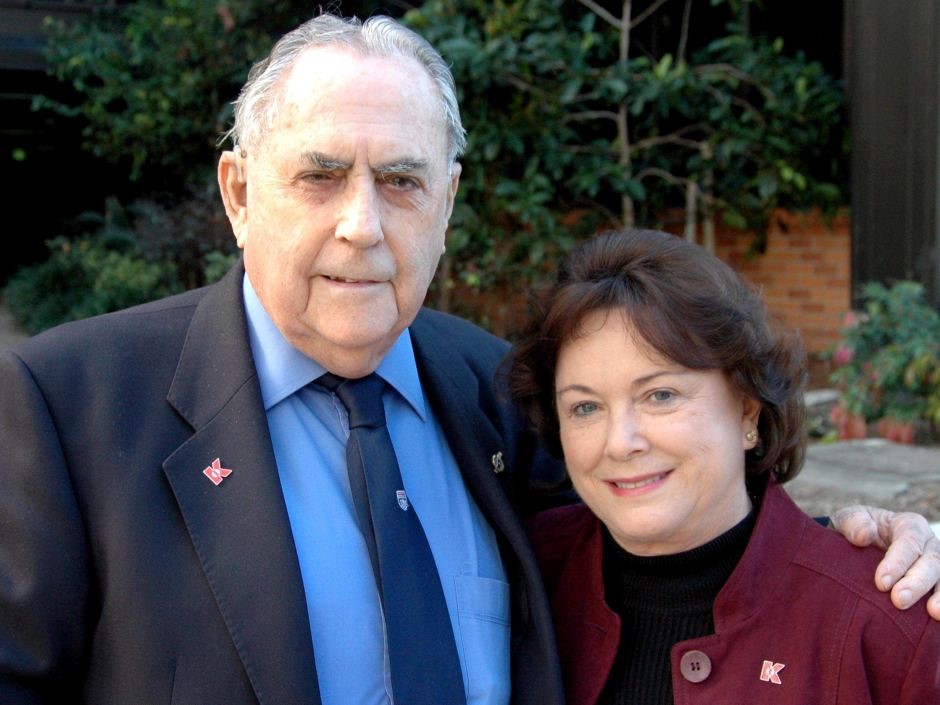
Sir Jack Brabham and his second wife, Lady Margaret Brabham, in Brisbane, July, 2009.
"So, on behalf of all at McLaren, I'd like to pay tribute to one of the most illustrious names in motor racing history and, above all, to extend heartfelt condolences to Sir Jack's widow Margaret and his three sons Geoff, David and Gary.
"Sir Jack Brabham, legend, RIP."
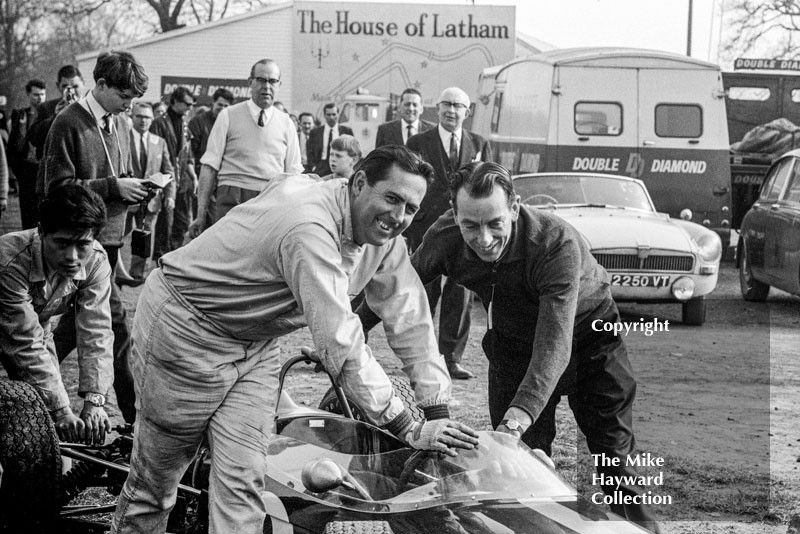
Jack Brabham: ferociously competitive racing driver and team owner who won the F1 world title three times. David Tremayne. 20 May 2014.
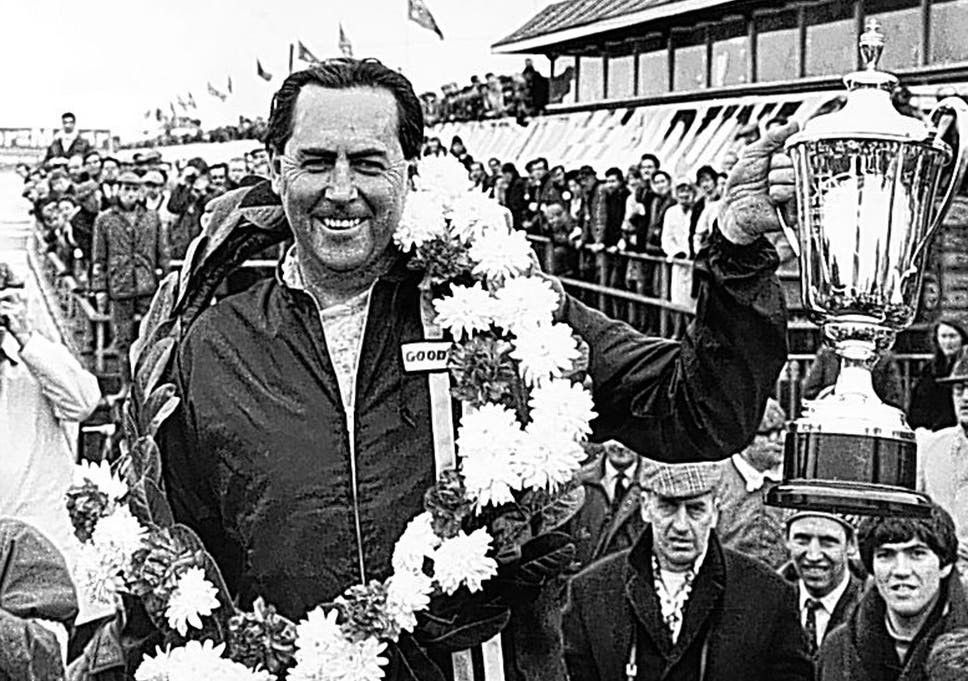
Brabham in 1969, after winning the International Trophy Race at Silverstone. Photo by Getty.
In a racing car Jack Brabham could be many things, yet most often he was under-rated. And that was just how he liked it. While the dominant Jim Clark, indefatigable John Surtees, mercurial Jochen Rindt and flamboyant Jackie Stewart frequently earned the headlines, the taciturn grocer's son from Sydney was more than happy to get by with a quick grin and, outside his circle of confidantes, rarely used two words when none would do.
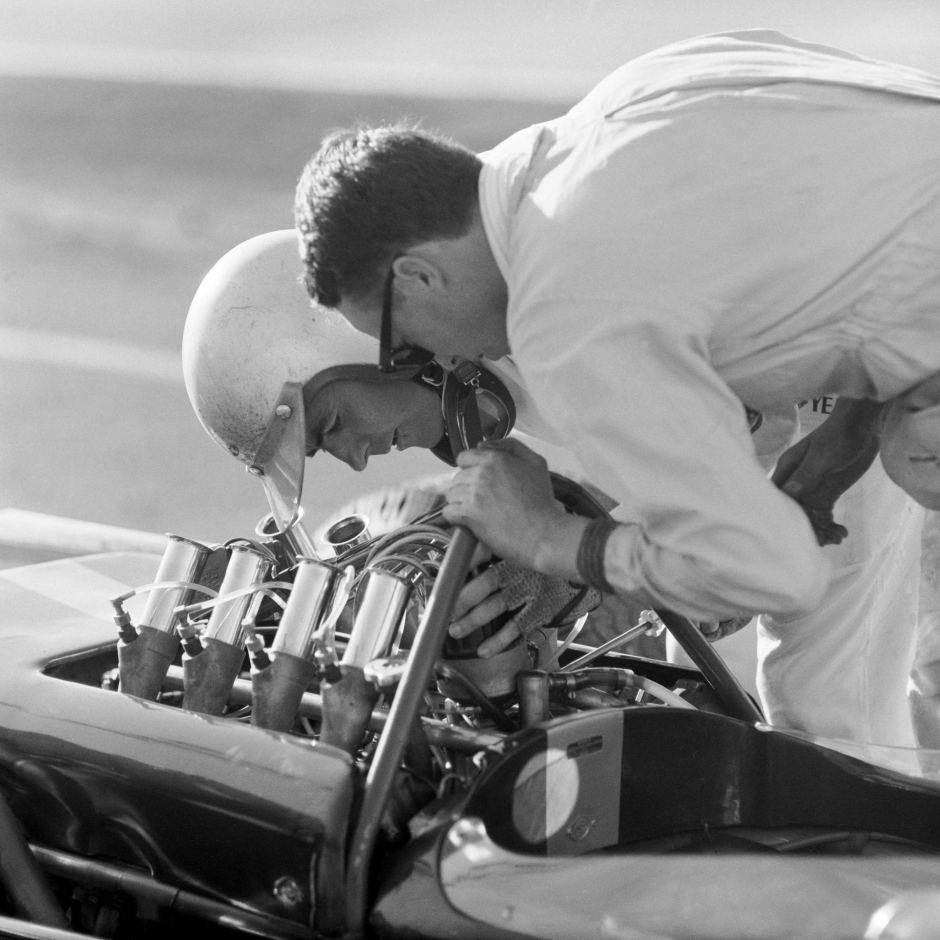
Jack Brabham checks his Repco Brabham engine before the start of an international event at Surfers Paradise, date unknown.
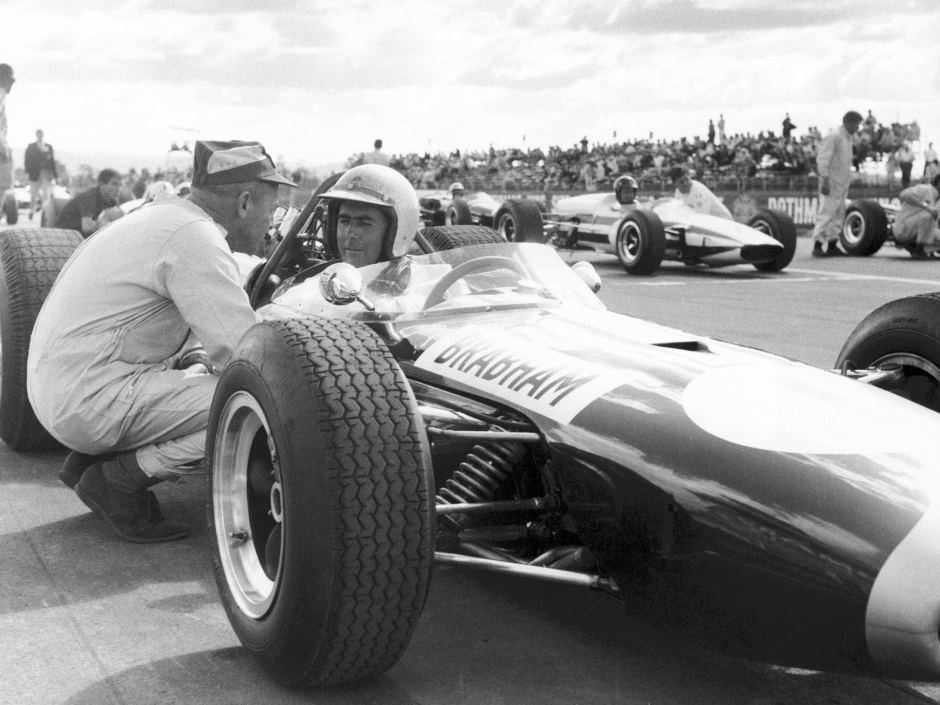
Jack Brabham prepares for an international event at Surfers Paradise, date unknown.
Yet he was a fearsome contender who on his day could beat the best of them. Right up until his final season, in 1970, he was capable of winning grands prix at the grand age of 44. And his legacy is a mighty footprint in motorsport.
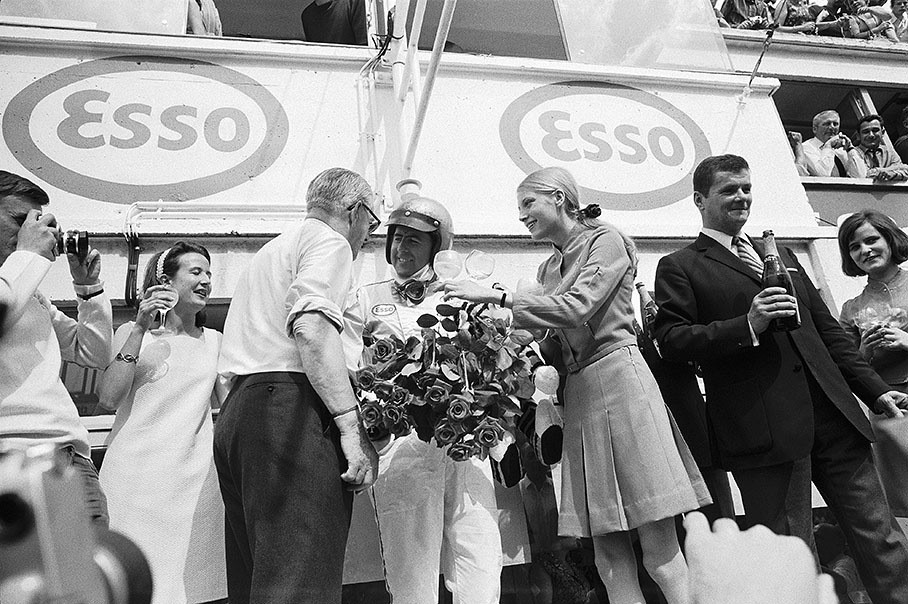
Jack Brabham enjoys his achievement and a glass of champagne on the podium after winning the French GP at Le Mans in 1967. Photo by Rainer Schlegelmilch.
But, though he was fiercely competitive, when he found himself fighting his team-mate and employee Denny Hulme for the 1967 crown he never once considered giving the New Zealander inferior equipment. When Hulme triumphed, Brabham was gracious in defeat as the car bearing his name also won a second world championship for constructors.
For 1962 he set up his own team, with his friend Ron Tauranac as the designer. Moss's legendary mechanic Alf Francis once said of Brabham: "he is that unusual combination of a first class engineer and a first class driver".
Sir Jack Brabham: family, friends and fans gather at racing legend's state funeral. 11 Jun 2014.
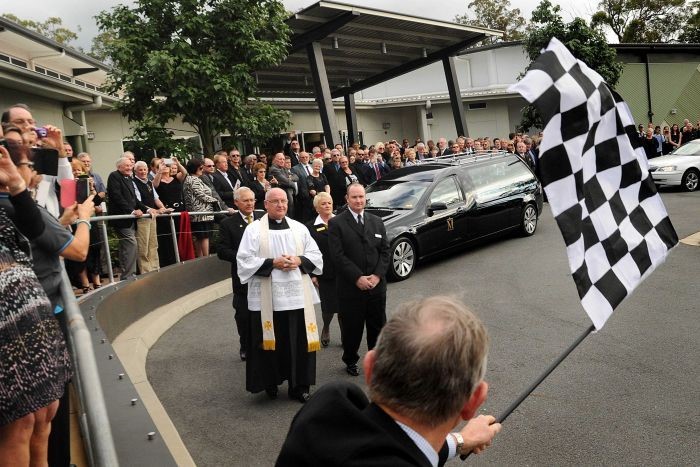
A checkered flag is waved to farewell Australian motorsport legend Jack Brabham at his funeral on the Gold Coast. AAP: Dave Hunt.
Australian motor racing legend Sir Jack Brabham has been farewelled at a state funeral on the Gold Coast.
The three-time Formula One world champion died at his Gold Coast home in May at the age of 88.
Sir Jack is considered one of motor racing's greatest drivers and team owners, whose sense of innovation helped to modernise the sport.
Queensland Premier Campbell Newman and Gold Coast Mayor Tom Tate were among mourners who farewelled Sir Jack at the Southport Church of Christ on Queensland's Gold Coast.
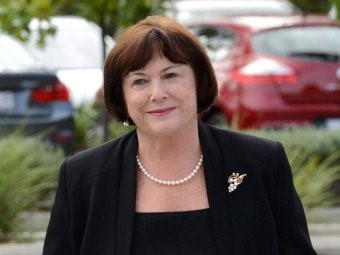
Lady Margaret Brabham arrives for the funeral of her husband on the Gold Coast. AAP: Dave Hunt.
Mr Newman called Sir Jack a "great Australian" who paved the way for other Australians to achieve success.
"Sir Jack was a champion who did it his way," Mr Newman said. "He was a battler who took on the world and who won, time and time again."
In a note to Sir Jack's family, Prime Minister Tony Abbott said Sir Jack had a "have-a-go" spirit and led an "inspirational life".
"Australia has lost a legend," Mr Abbott's note read.
As Jack Brabham’s coffin stood in front of the church, adorned with a gold helmet, steering wheel and racing flag, son Geoffrey paid tribute to his father.
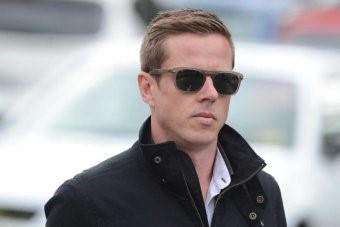
Australian V8 driver James Courtney was among those who paid tribute to Sir Jack Brabham. AAP: Dave Hunt.
Mr Brabham explained the state funeral had to be delayed because of the racing commitments of Sir Jack's grandsons Sam and Matthew.
"Dad would have got out of his coffin and kicked their arse if they missed a couple of matches for him," Mr Brabham said.
"He was a legend and a giant not only in motor racing but in all Australian sport."
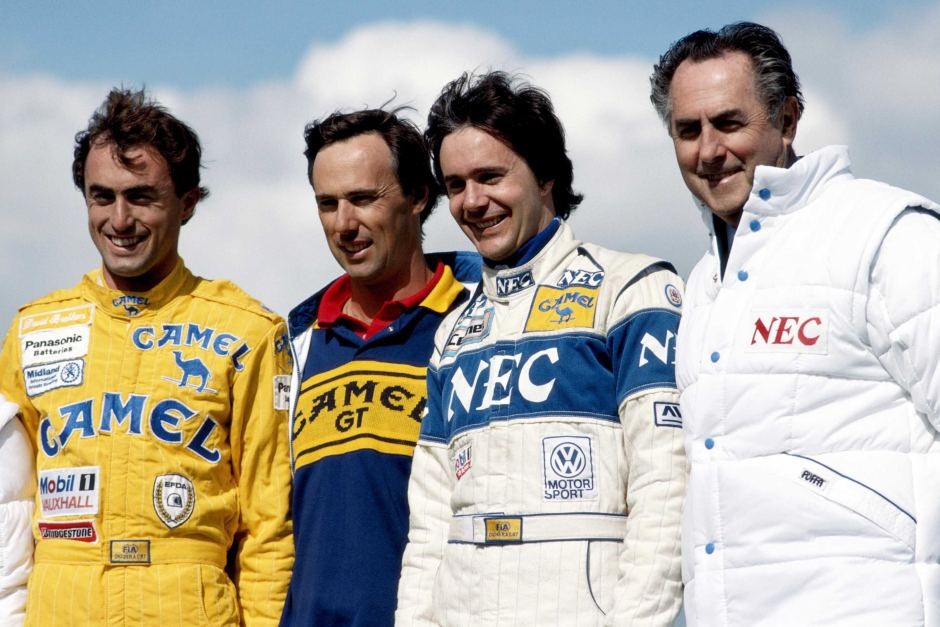
Sir Jack Brabham, far right, with sons, left to right, David, Geoffrey and Gary at the Silverstone Circuit in Great Britain, May, 1988.
Himself a racing driver, Mr Brabham added: "the only advice my dad told me my whole career was, he said there's the throttle, the brake, the steering wheel. If you crash don't come back."
Describing life with his dad as "never boring" he offered an insight into his father's character.
"Dad had his own plane and we flew to all the races together," he said.
"Dad always flew just above our house when he came back from a trip. It was to tell our mum to start dinner."
Mr Brabham also recalled a story about his father's final months.
"Someone had told dad a magnetic field would help slow his prostate cancer," he said.
"He brought an industrial size magnet and kept it in his undies.
"The cancer count went down...so dad gets all excited and got two magnets.
"They slammed together .. some of his more delicate parts squashed together.
"It was incredibly difficult to get two multi-grips on two industrial magnets apart when you're laughing and dad is rolling around in agony.
"He lived an incredible life and I don't believe you can ask for any more.
"I know he's up there trying to talk someone into building something so they can race together."
Flags on government buildings flew at half mast today in honour of the motor racing legend.
Describing Sir Jack as a "national treasure", Australian Grand Prix CEO Andrew Westacott said: "he just took on the world and won."
“Meeting Sir Jack Brabham was an experience this revhead will never forget. I can only imagine what those who saw him racing in the flesh are feeling ahead of his state funeral today”, writes Zane Bojack.
Mr Westacott revealed from next year, the Australian Grand Prix's trophy will be re-named after the racing legend.
"Australian and international drivers alike can aspire to win the Sir Jack Brabham Trophy," Mr Westacott said.
"He's the greatest ever racing driver we've had and he's revered around the world as the only person to win a Grand Prix Championship and build the car in the same year and that's never going to happen again."
Motor racing experts agree Sir Jack's achievements of winning both the Formula One Drivers' Championship and Constructors Championship will not be repeated.
Sir “Black Jack” Brabham
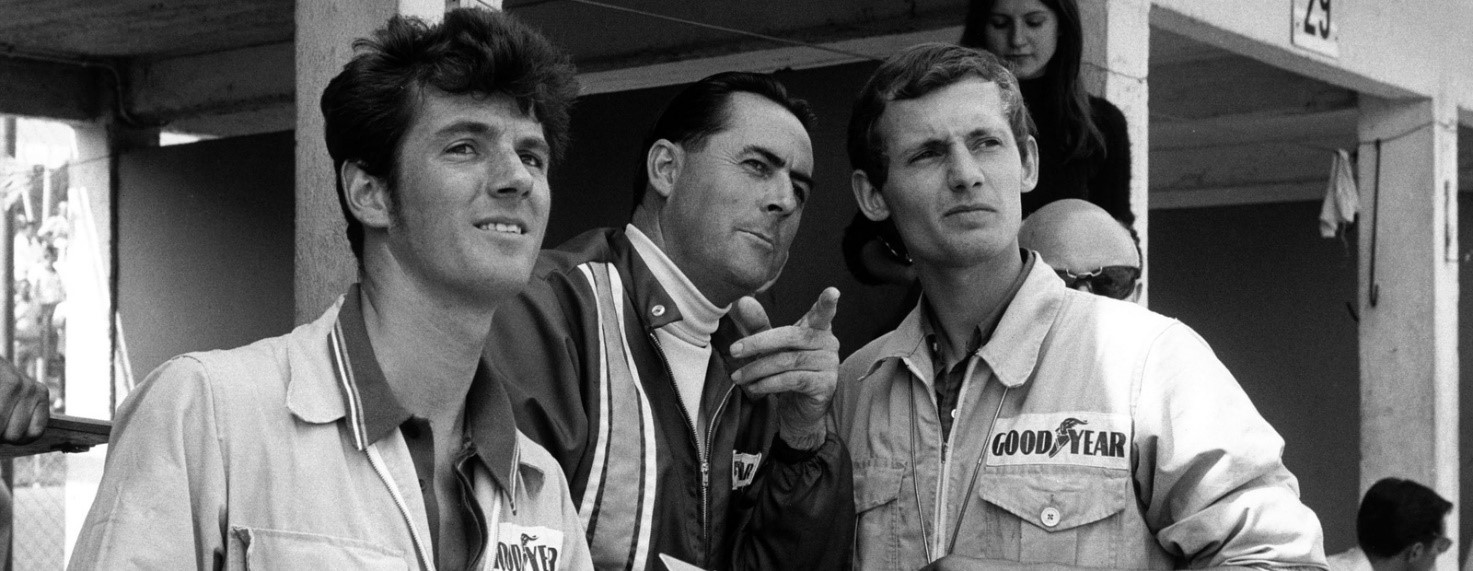
Jack Brabham and Ron Dennis. Courtesy of mclaren.com.
“I was only ever interested in beating Ferrari, not joining them.” Jack Brabham.
It was after he had received his OBE from Her Majesty the Queen in 1978 that the newly knighted Sir Jack Brabham went out to the Buckingham Palace car park and discovered that his car would not start. It was the starter motor. So it was off with the top hat and tails jacket, roll up the shirt sleeves and get busy under the bonnet, with a politely impatient Palace police officer leaning over his shoulder asking “will you be long sir?”
Jack Brabham was a roll up your sleeves man with a love of mechanics, a head for business and a genuine interest in people, who didn’t start out wanting to be a racing driver. He wanted to be an engineer and his introduction to motor racing came quite by chance.
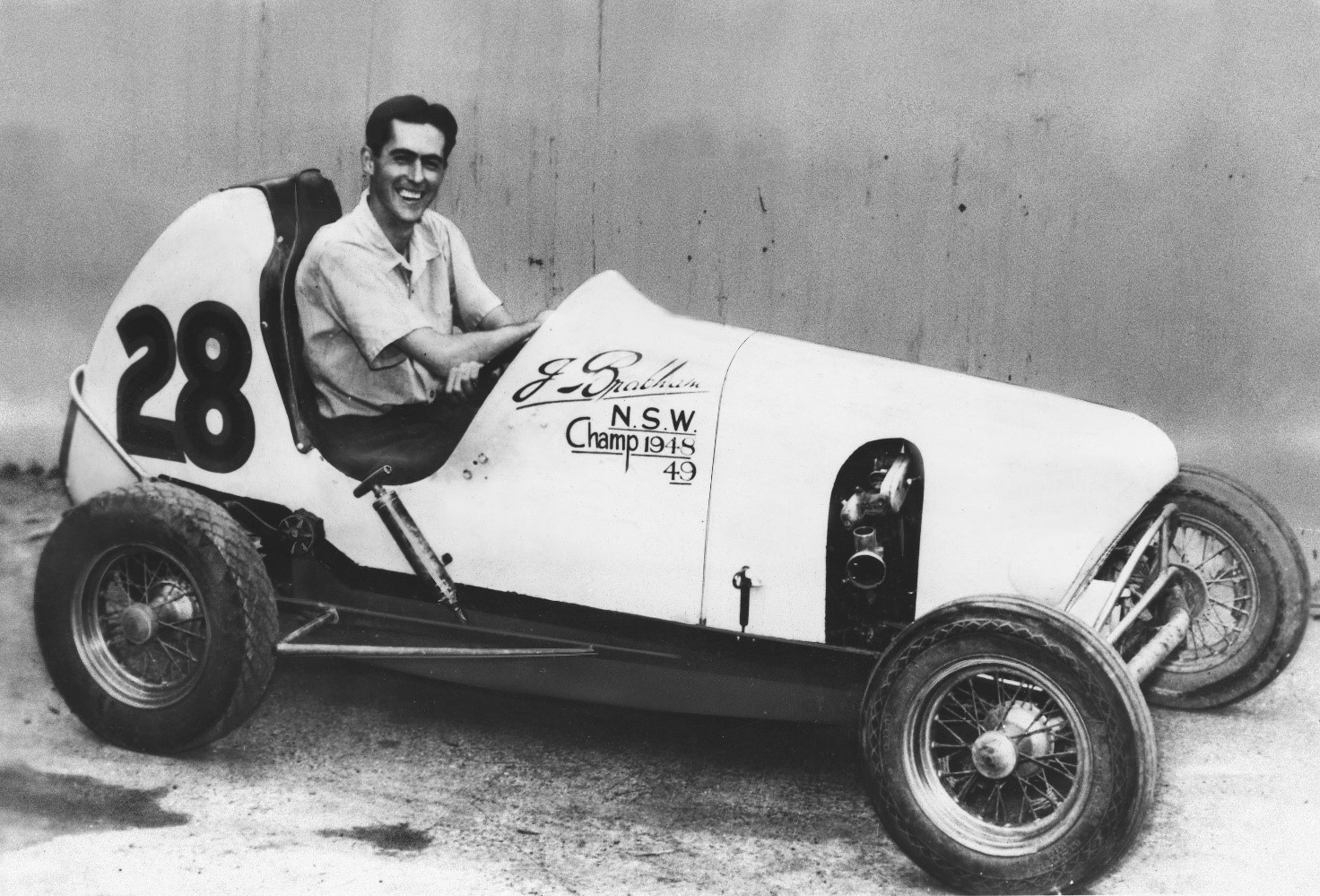
A young Jack Brabham in his Australian Speedcar, having discovered that racing driving is fun. Picture courtesy news.cision.com.
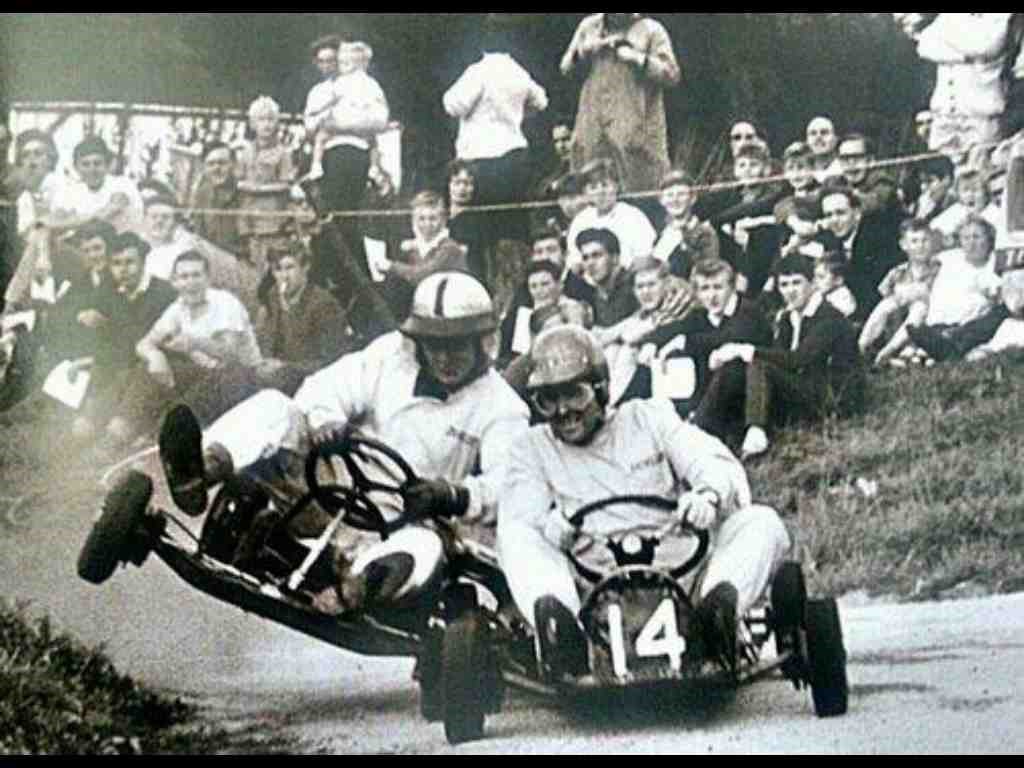
Here we see Jack Brabham demonstrating his exuberant racing methods that earned him the nickname “Black Jack” to a young Bruce McLaren.
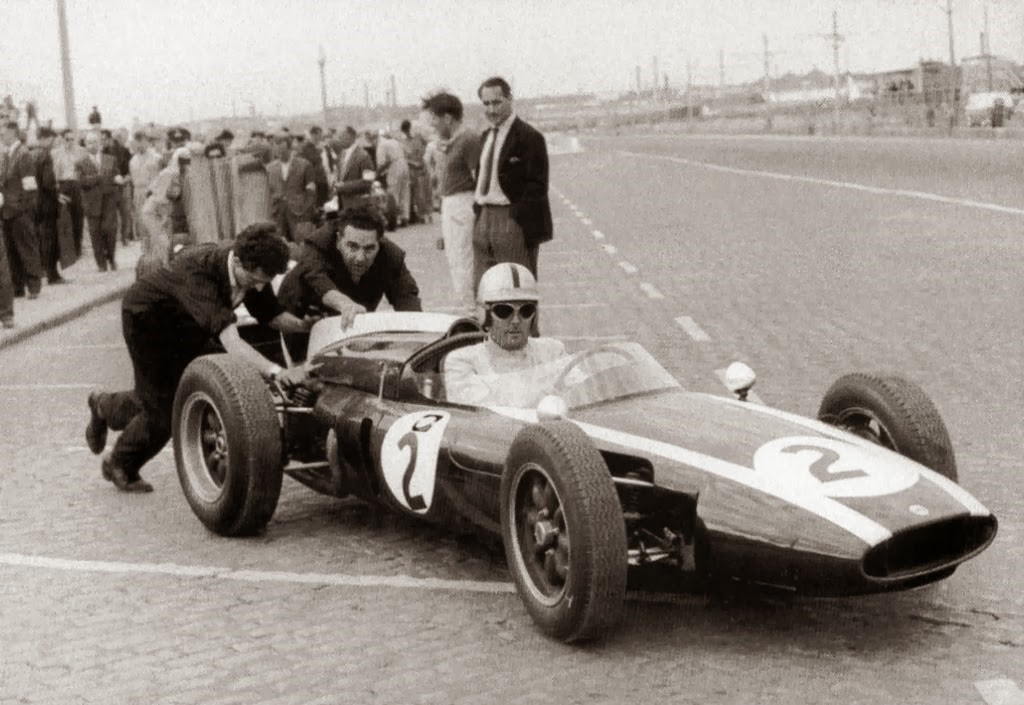
Jack Brabham at the start of the 1960 Portuguese Grand Prix in a Cooper T53. Picture courtesy Wikipedia.
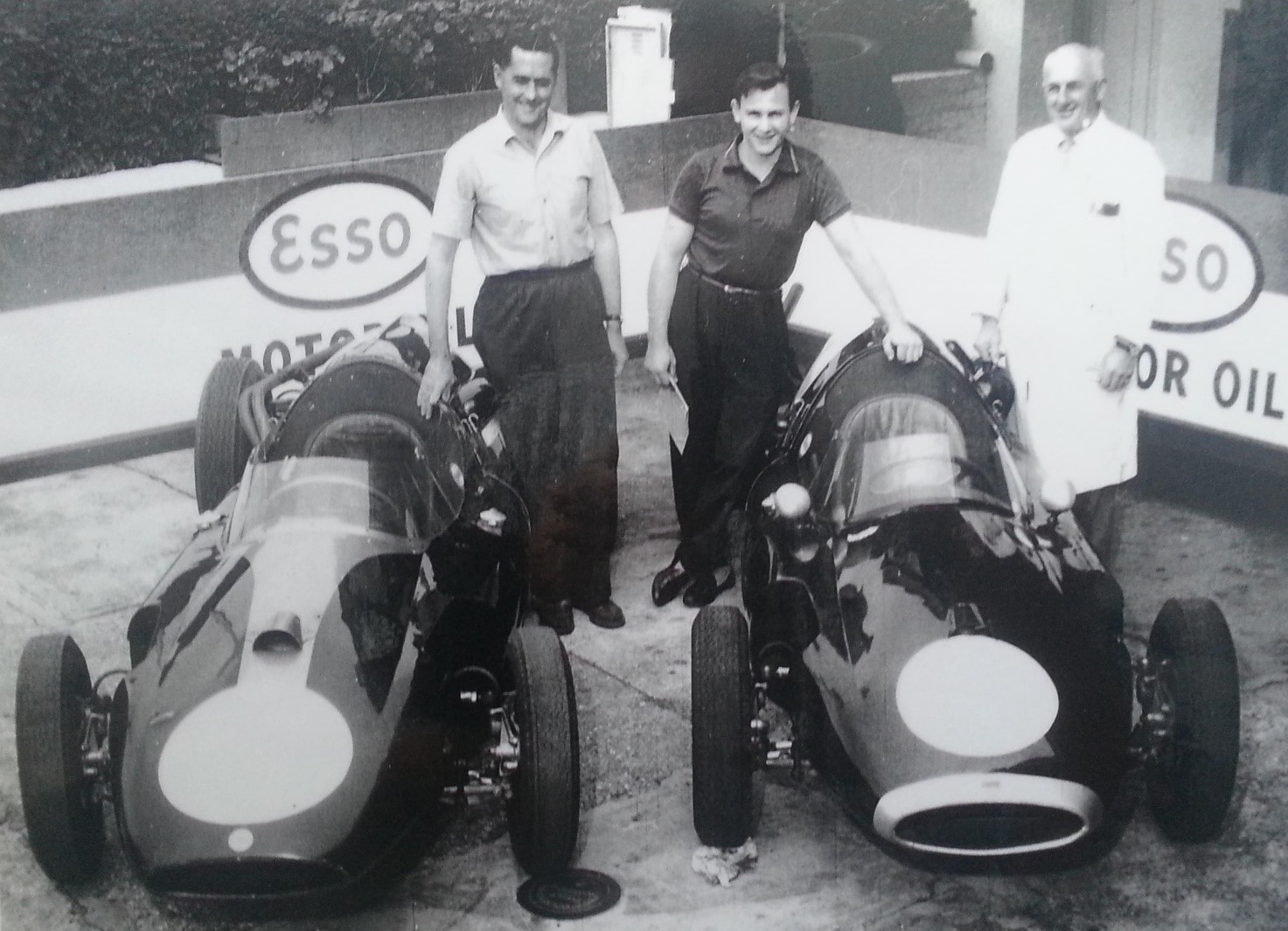
Team mates at Cooper, Jack Brabham and Bruce McLaren. Picture courtesy jornaldeservicos.com.br.
A strong friendship developed between Jack Brabham and Bruce McLaren, which some have described as almost being like a father and son relationship. Both were driving for Cooper, Jack Brabham leaving to set up his own Brabham Racing Organization in 1962 and Bruce McLaren setting up Bruce McLaren Motor Racing Ltd. in 1963.
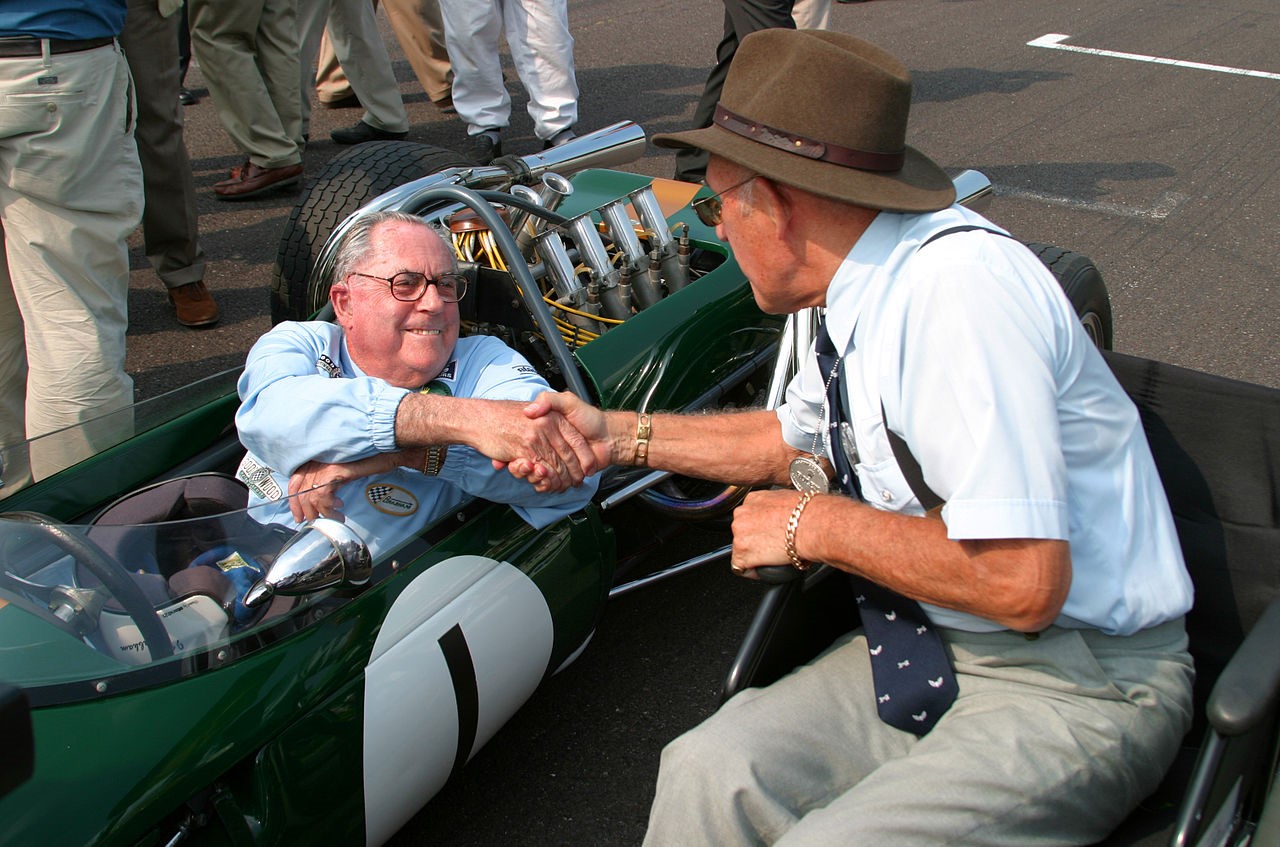
Jack Brabham and Stirling Moss at the Goodwood Revival in 2004. Picture courtesy Wikipedia.
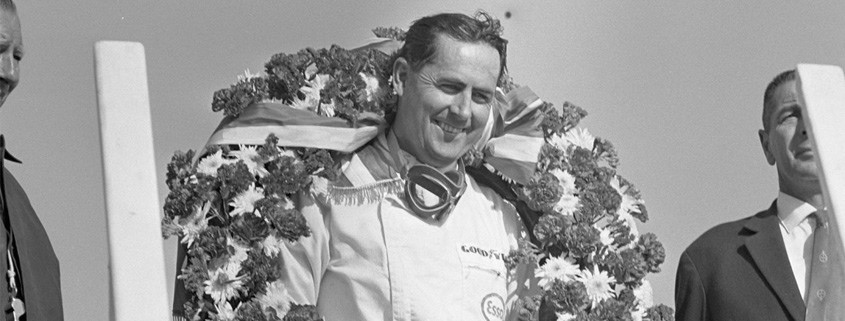
Jack Brabham also left his autobiography as a legacy for those of us left behind. It is called “The Jack Brabham Story”.
Pit stop on the set of 'Grand Prix' with Françoise Hardy. 10 November 2013
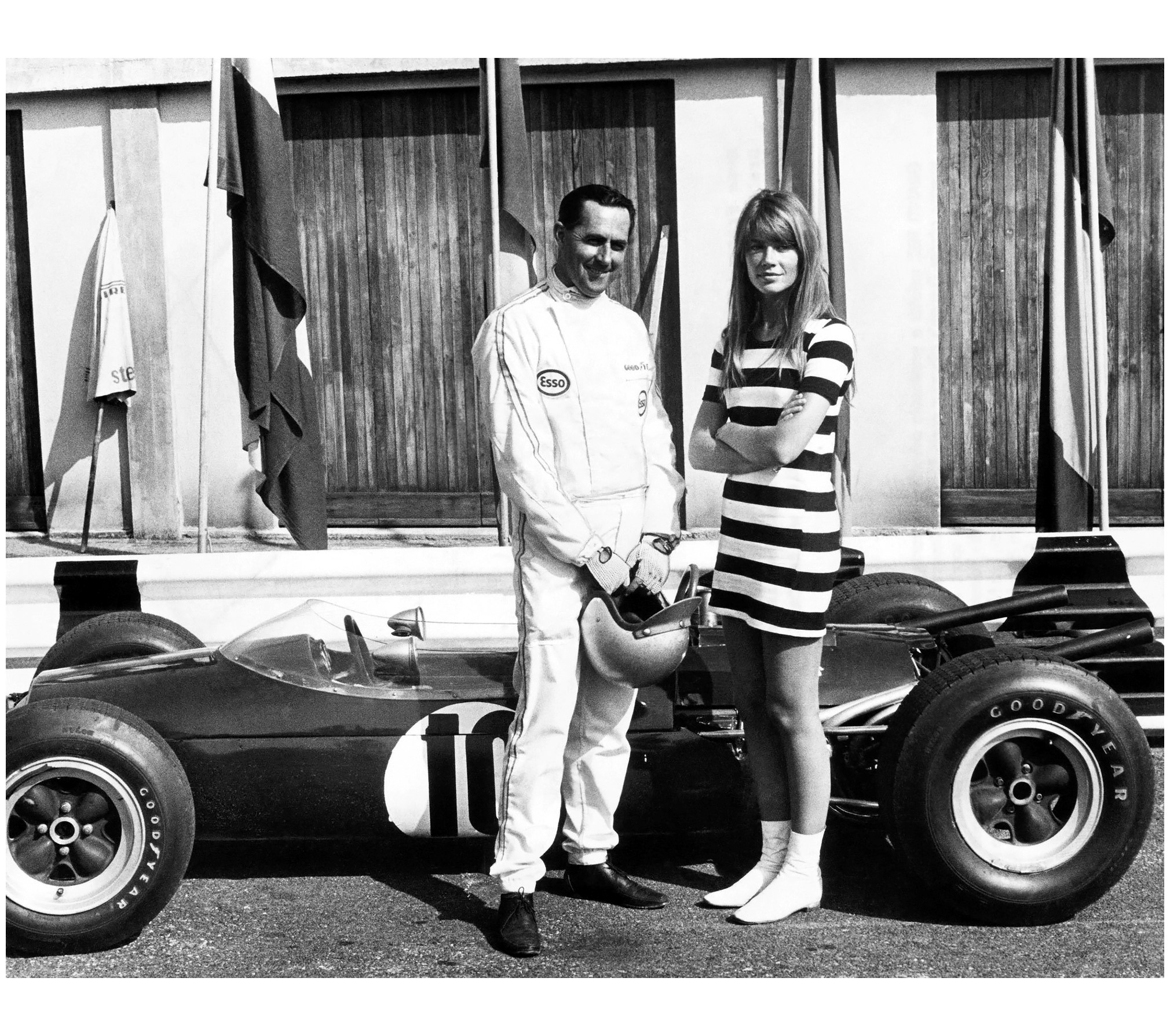
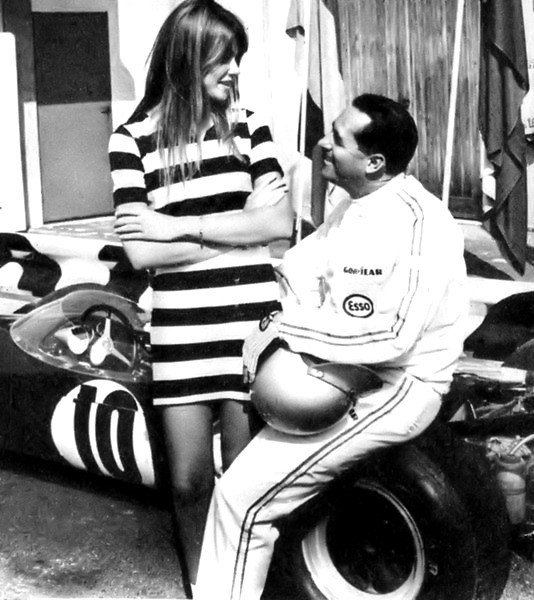
Francoise Hardy and Jack Brabham in 1966.
John Frankenheimer's 1966 film, a fast-paced story of Formula 1 excitement, featured many genuine racing legends on set - and a young French singer by the name of Françoise Hardy...
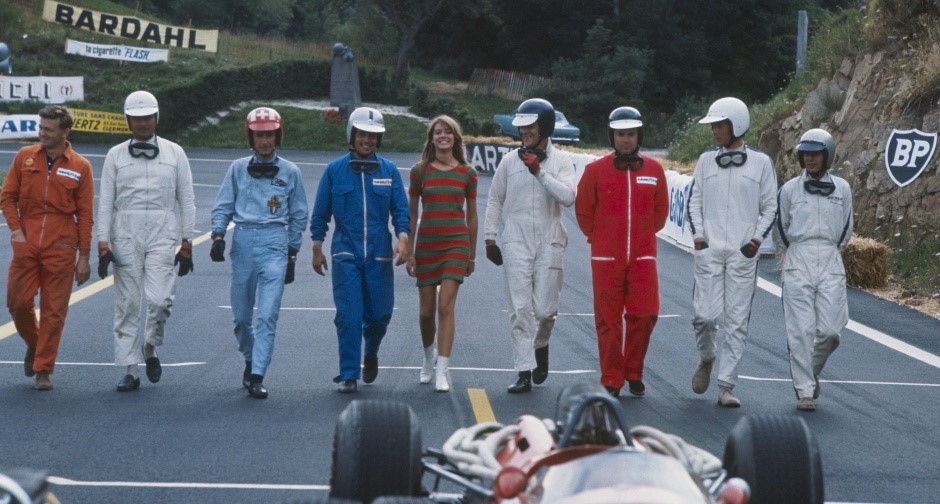
With James Garner, Eva Marie Saint, Yves Montand, Brian Bedford, Antonio Sabàto and Toshiro Mifune in starring roles, John Frankenheimer had put together an impressive international cast. Yet the real reason for the success of 'Grand Prix' - one of 1966's ten biggest box-office hits that year, winning three Oscars - was the thrill of the racing scenes, thanks in large part to help from Phil Hill: he captured real-life footage with on-board cameras at some 1966 Grands Prix and also drove a GT40 camera car during the making of the film. Other big names making guest appearances on screen included Graham Hill, Juan Manuel Fangio, Jim Clark, Jochen Rindt and Jack Brabham.
Fast cars, melancholy looks
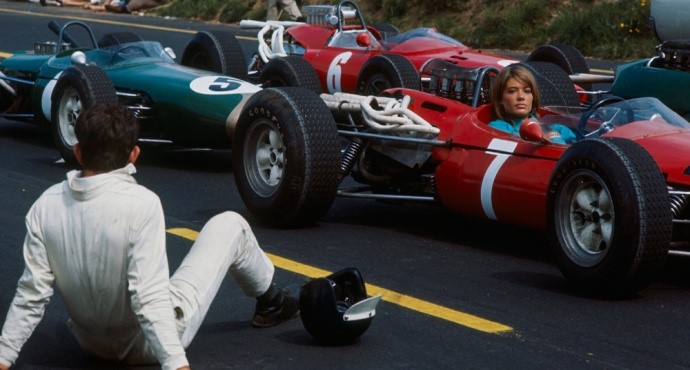
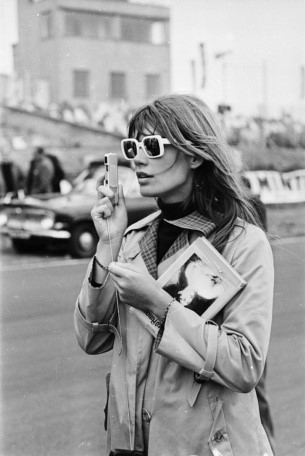
Francoise Hardy, sunglasses and camera.
There was another reason for movie-goers to buy tickets and that was the actress who took the role of driver's girlfriend Lisa, namely the alluring Françoise Hardy.
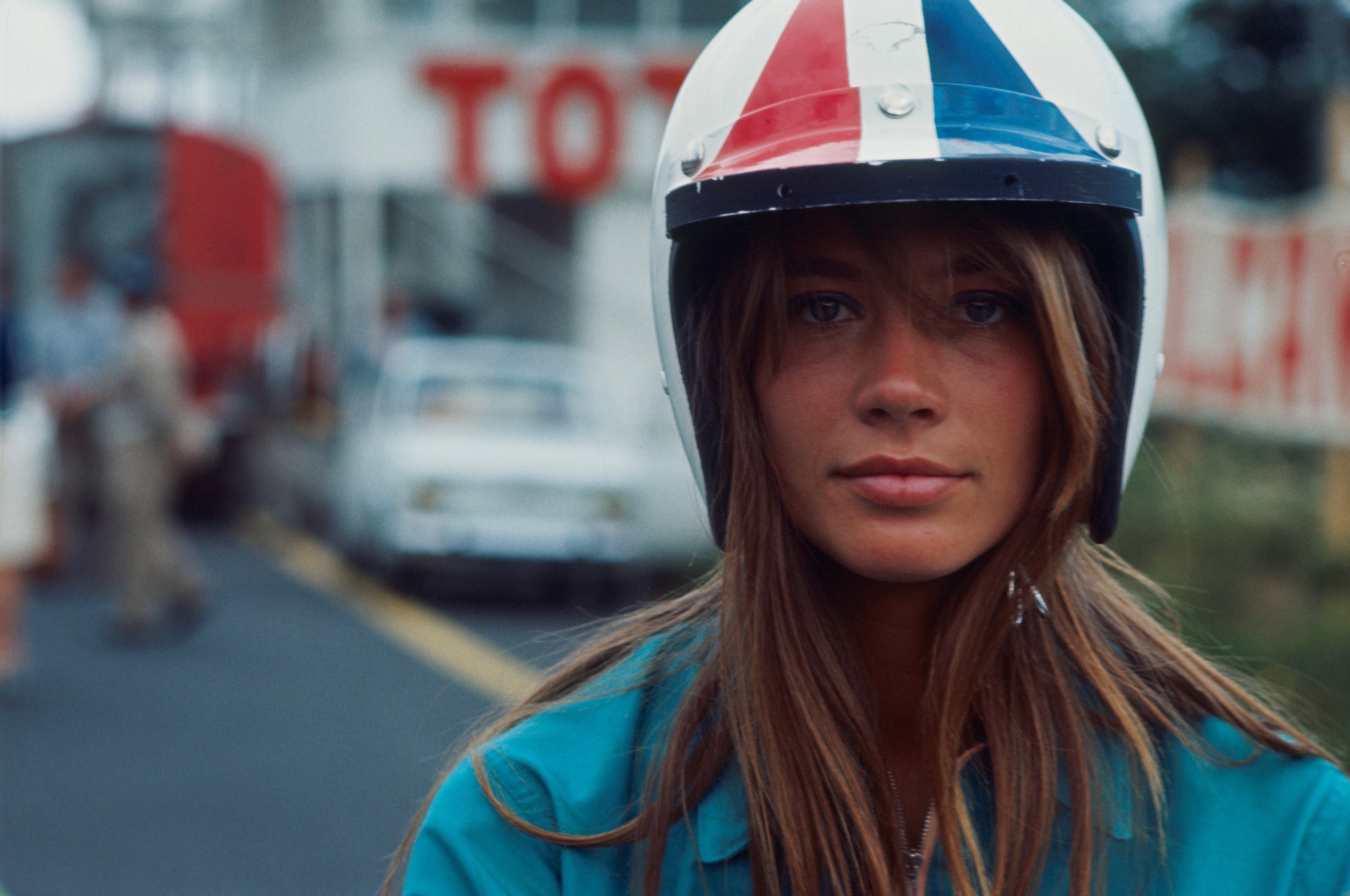
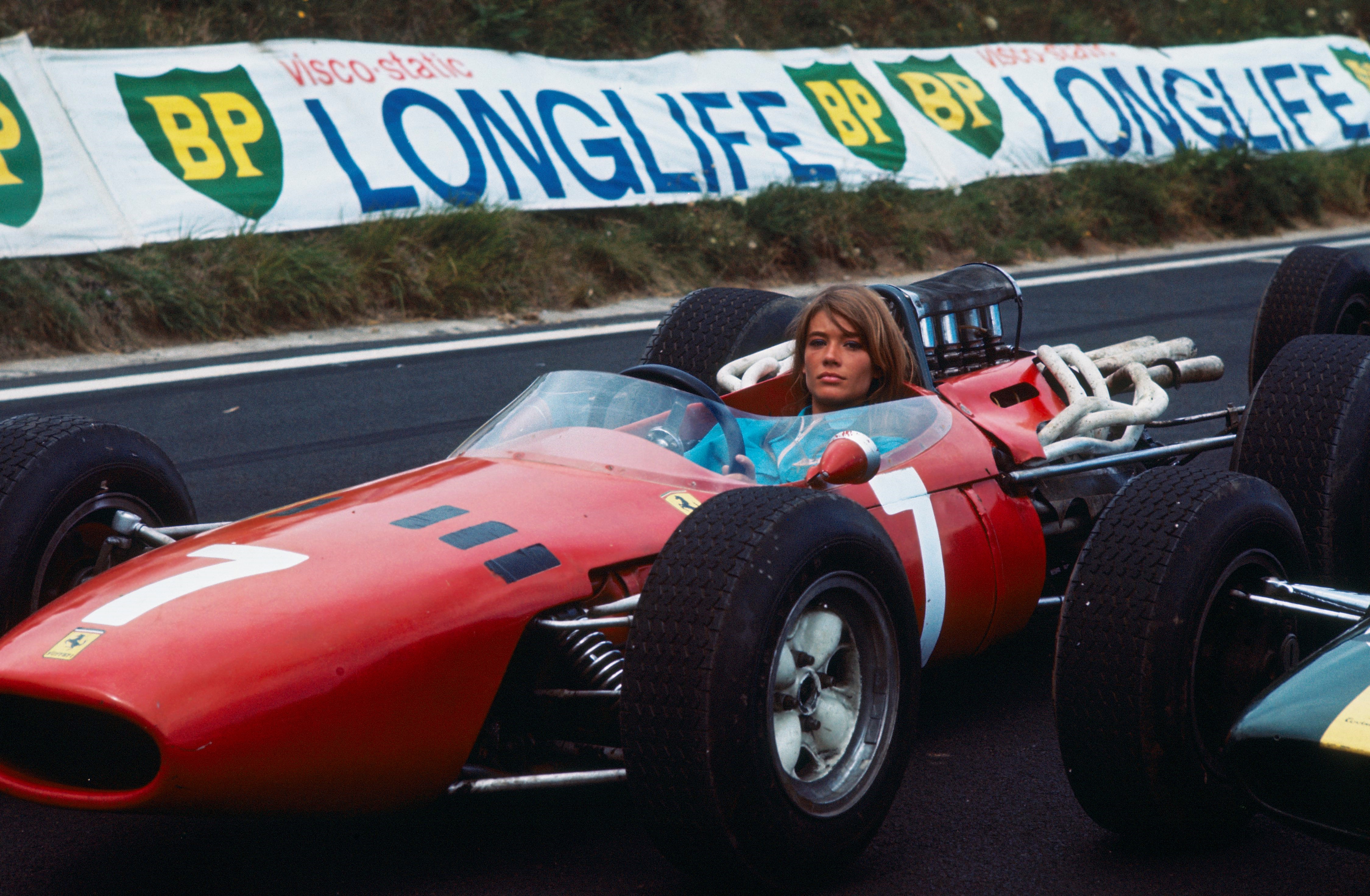
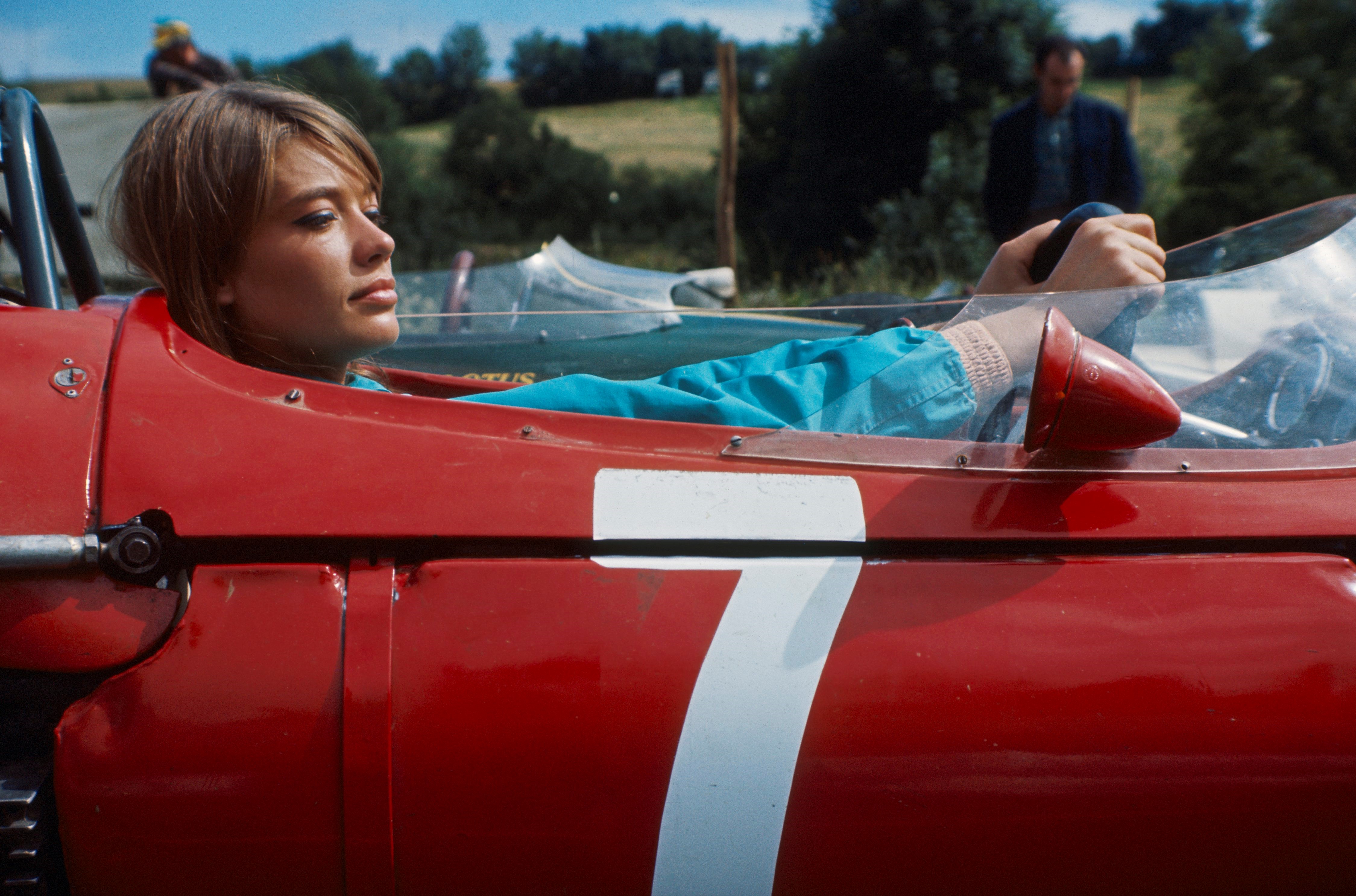
Françoise Hardy.
Her melancholy looks and gentle smile had already bewitched Mick Jagger and David Bowie and on the set of Grand Prix, where she posed wearing the helmet of fellow actor James Garner and at the wheel of a Ferrari, she likewise put the film crew under the spell of her innocent charm. She actually suffered from severe stage fright and hated being the centre of attention; hence the picture below, in which she perches, somewhat lost-looking on a float to help launch the film in New York, is all the stranger.
From Grand Prix to style icon
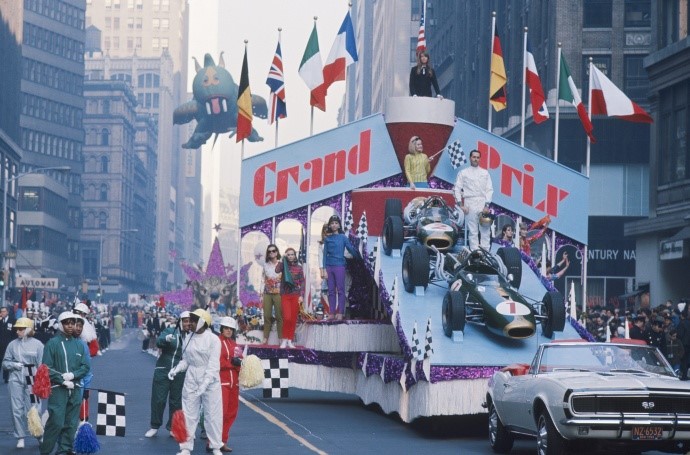
From the 1970s onwards, Françoise Hardy was only rarely seen in public, although she was still very much in the public eye thanks to her fashion photoshoots for Dior and Yves Saint Laurent.
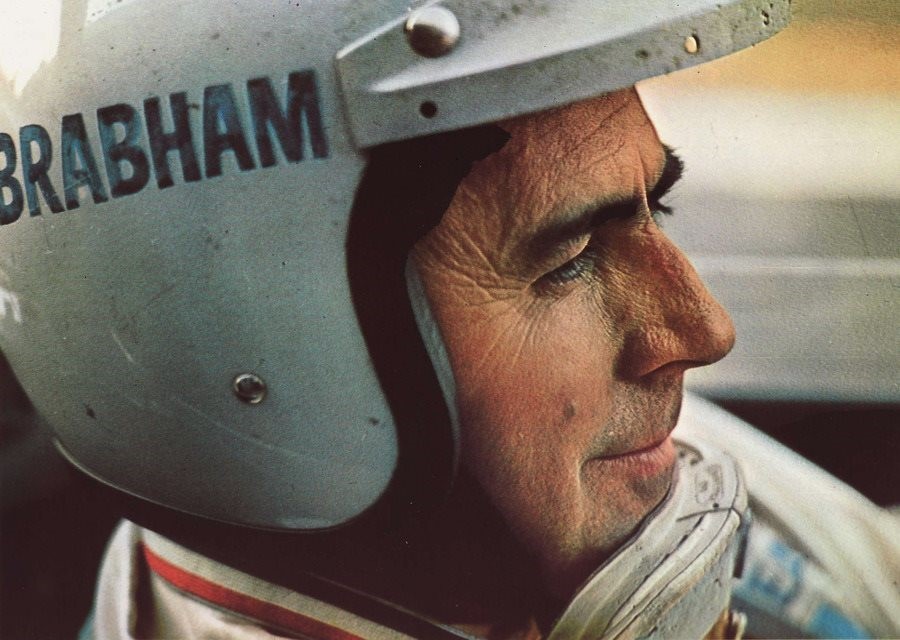
Documentary shines new light on F1 legend Jack Brabham. By Brad Newsome. August 5, 2020.
This new feature-length documentary about Australian F1 legend Jack Brabham is many things. It's celebratory and critical, it's evocative in its chronology, impressive in its list of interviewees and eclectic and idiosyncratically busy in its visual style. What it can't quite do in the end is give the viewer a completely satisfying sense of the man himself - who seems to have remained something of a closed book even to people who knew him for many years. Everything else, though, comes into compellingly sharp focus. The raw stats of Brabham's F1 career you can see up the top of his Wikipedia page: 126 starts, 14 wins, 31 podiums and three world championships.
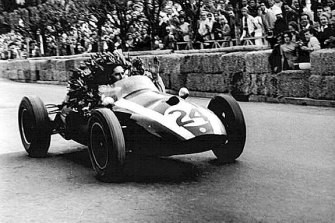
Jack Brabham pictured winning the Monaco Formula One Grand Prix in 1959.
Writer-director Akos Armont and writer Tony Davis bring them to life, beginning with the sheer, terrifying danger of motor-racing in the postwar period. Brabham was at Le Mans in 1955, when crash debris flew into the crowd, killing 83 spectators. Three months later death came even closer when his co-driver, Jim Mayers, died in a fiery crash in a race in Northern Ireland. Brabham, of course, persevered in extraordinary style - in 1959 he would literally push his car across the finish line in the race that secured his first Formula One championship.
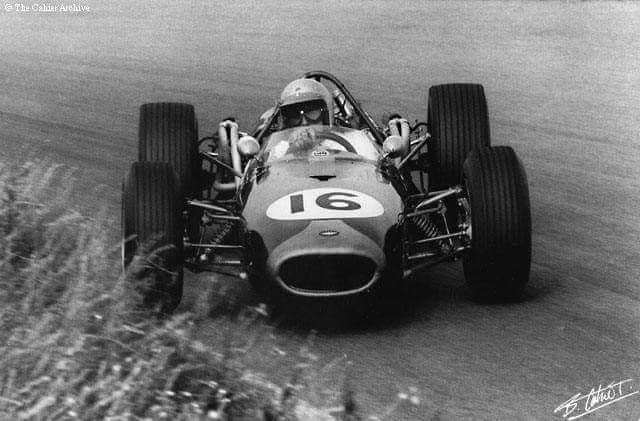
"Brabham seems to have not yet understood that he no longer races on the dirt roads of Australia and continues to exit from the curves into power oversteer." Stirling Moss
The magnitude of his achievement is underlined here by the recollections of contemporaries, including Jackie Stewart, Stirling Moss and John Surtees, as well as Ron Tauranac, the engineering genius who co-founded Brabham's constructor and racing team in 1962.
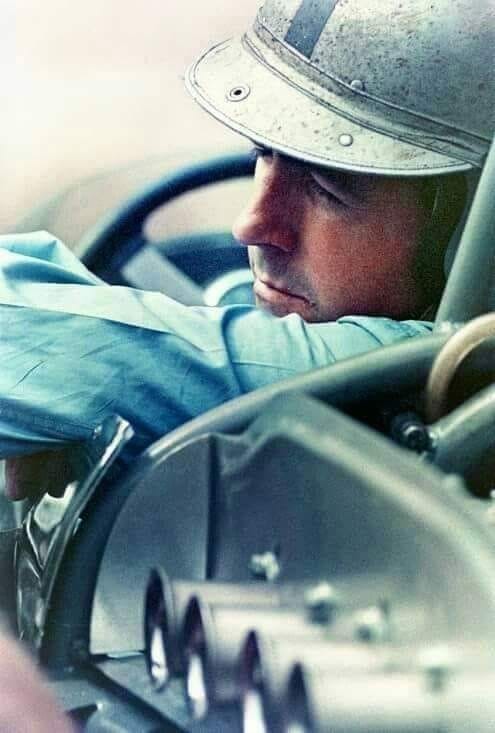
"Jack Brabham arrived at the Grands Prix after a week of work in the workshop. Had he dedicated himself only to racing he would have dominated in the manner of Fangio." Derek Gardner
But, while Brabham gets plaudits for his generosity in mentoring future rivals, the film doesn't shy away from his reputation for ruthlessness, which apparently extended to deliberately driving so as to throw stones and gravel at the cars behind him. "I've had more marks on my helmet from Jack Brabham than I have in any accident," Stewart remarks. Unusually for a sports biography, Brabham also highlights the effect that Brabham's long absences and taciturn personality had on his family. Particularly when it comes to Brabham's Le Mans-winning son David, who is taking the family name forward with the Australian-made Brabham BT62 supercar and to whom Armont increasingly turns his focus in the later part of the film. It's an engrossing, illuminating piece of work and a particularly timely one in capturing the recollections of Tauranac.
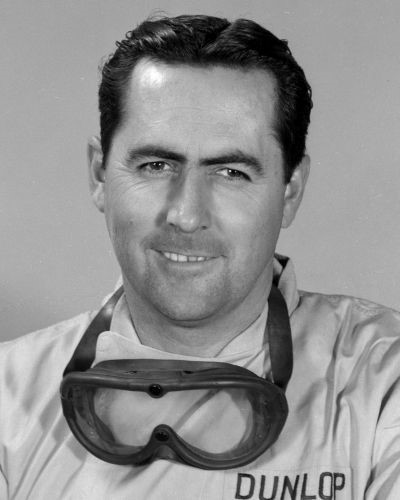
The Story of Jack Brabham - Aussie Grit. The full story of Australia's greatest racing driver. (Besides Mark Webber, of course). Jeremy Ethan Ibrahim posted in Motorsport Community 1 year ago.
Jack Brabham is one of the greatest men in the history of Motorsport. His name is synonymous with world-class racing for over 70 years as he was in charge of one of the most successful teams in Formula 1 and is the only driver in history to win a World Championship title in a car developed from scratch by its driver, bearing his name. With humble beginnings in the Royal Australian Air Force, he made his way up to the grand stage, making sure the world knew his name.
In 1957, Braham had nearly avoided a huge crash in the first corner at the 1957 Monaco Grand Prix. In the middle of the race, his fuel pump broke down. Enraged, Brabham pushed his Cooper to the absolute limit and had made a comeback securing sixth place. During an interview, he simply said that "he hated to be beaten."
Because of all the races Brabham had to attend, he had to travel across Europe frequently. He was a good driver on the road, with his driving described as being "as safe as houses", unlike other of his contemporaries. However, driving across Europe wasn't efficient for him, as he would need a lot of energy to drive for countless hours. His solution? He applied for a pilot's licence and bought his own plane, as he had personal, hands-on experience with handling and maintaining aircraft. He would fly his family and team members to various races around Europe.
Brabham won his first championship race at the 1959 Monaco Grand Prix after a multitude of events happened in his favor, such as Jean Behra's Ferrari and Stirling Moss' Cooper failing. He managed to secure even more podium places afterwards, winning the British Grand Prix. Brabham had narrowly avoided death during the Portuguese Grand Prix when Stirling Moss' car flipped and threw his car off the track. He escaped with no injuries.
Brabham was doing successful with Cooper, winning races here and there. However, he was sure he could do even better and realized that his car was limiting his true potential. He invited his friend Ron Tauranac to come to the UK to work alongside him to develop upgrade kits for the Sunbeam Rapier and Triumph Herald road cars at his car dealership, Jack Brabham Motors. However, his main focus was to further develop race cars.
Some masterpieces that were born out of that partnership were the Cooper T53, which Brabham drove to win the Monaco, Dutch, French and Belgium Grand Prix in a row. His teammate, Stirling Moss was heavily injured during a practice session and had to be put out for two months, giving Brabham a massive advantage. During the Portuguese Grand Prix, he made a comeback after slipping on some tramlines and won second place after race leader John Surtees crashed.
His cars were starting to get outclassed though, with new competitors coming from big brands such as Porsche, Lotus and Ferrari. Brabham scored only three points and finished 11th in the championship against the new competitors. He had a little more success in the non-championship Formula One races, where he ran his own private Coopers and took three victories at Snetterton, Brussels and Aintree.
In 1961, Brabham entered the world famous Indy 500, the most prestigious race in the United States. Racing in a modified Formula One Cooper, it produced 268 horsepower from a 2.7-liter Climax engine. Its displacement and power output was dwarfed by the competition though, with most of the cars powered by 4.4-liter Offenhauser engines producing 430 horsepower. However, Branbham's Cooper had a mid mounted engine, giving him a handling advantage over competitors.
During qualifying, Brabham had secured a respectable seventeenth place at 145 mph or 233 kph. The front-engined Offenhauser powered cars were faster in a straight line, but the Cooper driven by Brabham handled better through the turns in the North and South sections of the circuit. Despite him finishing seventeenth place, his car had left a mark, triggering, in Brabham's words, "a rear-engined revolution at Indy". Five years later, most of the cars that raced at Indianapolis would be rear-engined.
Unfortunately, the 1968 season would go badly for Brabham. He retired from the first seven races after being plagued by mechanical problems, before scoring fifth place at the German Grand Prix. He retired from the remaining four races. After that appalling season, Brabham had fulfilled his desire to fly from Britain to Australia in a small twin-engined Beechcraft Queen Air. In the 1969 season, Brabham had suffered serious injuries to his foot after getting involved in a testing accident. He retired shortly after and sold his share of the team to his friend, Ron Tauranac.
Brabham could find no other driver, despite coming close to bringing Jochen Rindt back into the team. The year 1970 would be his final season. At first, it looked like a good start, as he won the South African Grand Prix. He lead the third race, the Monaco Grand Prix, until Rindt overtook him on the last turn of the final lap after his wheels locked. In Brands Hatch, he ran out of fuel mid-race. After the thirteenth and final race in Mexico, Brabham retired. In the end, he was tied with Jackie Stewart for fifth place in terms of driver points. Jochen Rindt would take champion.
The Mexican Grand Prix would be his final race of his Formula 1 career. After the season ended, along with a few races in the 1970 World Sportscar Championship, Brabham took a complete break from racing and flew back to Australia to the relief of his wife who had been "scared stiff" each time he drove. Brabham and his family moved to a small farm between Sydney and Melbourne. He never really wanted to move, but he placed family ahead of his own desires. His wife hopes that his children would grow up away from motorsport.
Brabham started up a few small businesses in the United Kingdom and Australia, including a small aviation company and a few car dealerships. Brabham and his former colleague, John Judd, who had worked on the Brabham BT19's Repco engine, founded the Engine Developments Company in 1971. They specialize in racing applications.
The Brabham Racing Company continued in Formula 1 under Bernie Ecclestone's onwership. Unfortunately, the company went bust in 1992. A revival was planned in 2010, but the deal fell through.
Despite his wife hoping her children would grow up away from motorsport, Brabham's youngest son, David Brabham, founded Project Brabham, a new LMP2 team using crowdsourcing as a source of finance. The team plans to become a fully fledged LMP1 constructor. However, they have not entered a car in any series. Brabham is looking to return to Formula One, but financial matters needed to change before they would partake in the racing series. All of Brabham's children grew up in motorsport.
As Brabham was aging, he had to go through some major health problems. By the late 2000s, ill-health was preventing him from driving in competition. In addition to the deafness caused by years of motor racing without adequate ear protection, his eyesight was reduced due to macular degeneration and he had kidney disease for which by 2009 he was receiving dialysis three times a week. He tried his best to attend motoring events, such as the Phillip Island Classic festival of Motorsport and the 60th anniversary of the Formula 1 World Championship in Bahrain.
"The driver is alone in the cockpit but it's a team effort which puts him there."
Sir Jack Brabham.
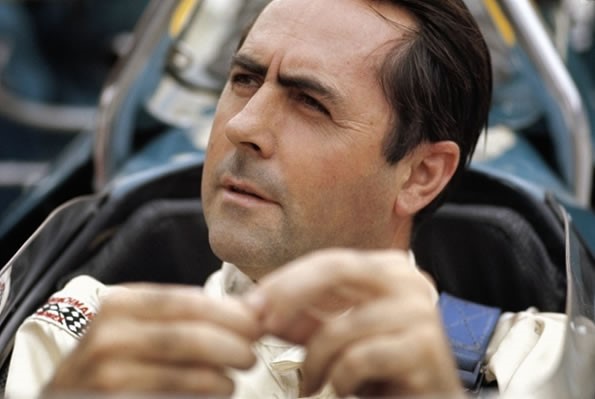
Jack Brabham.
Motor racing legend Sir Jack Brabham, the oldest living Formula 1 champion, has quietly passed away. He died at his home in Australia. He was eating breakfast with his wife, Margaret, when he passed away. He was a towering figure of his era, the first motor racing knight of the modern era.
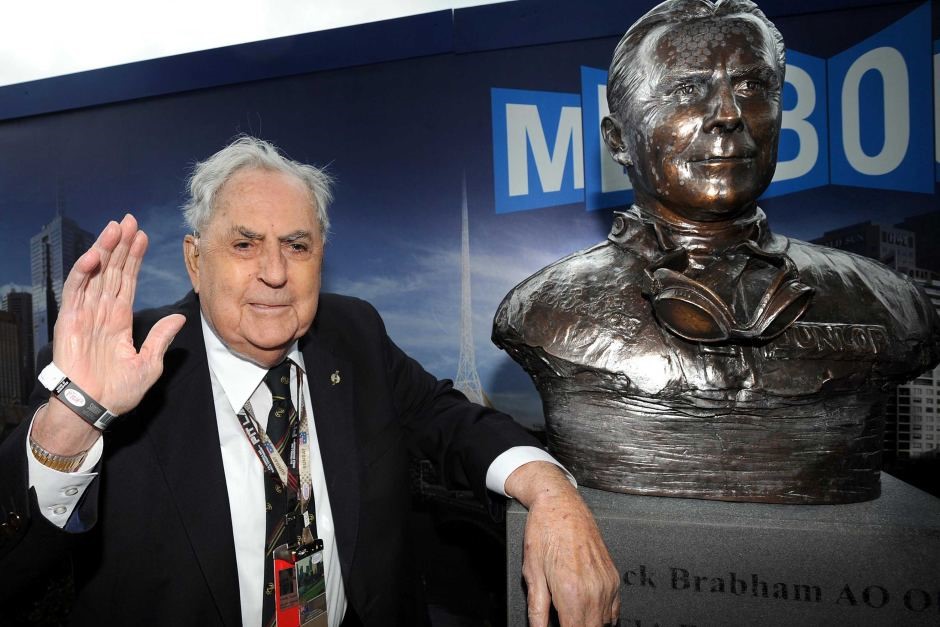
Sir Jack Brabham was a pretty damned good, albeit sometimes under-rated driver, but it was the engineering challenge which gave him the real satisfaction.
The grandson of a Londoner from the Cockney area of East London, who emigrated to Australia in 1885 and opened a grocer’s shop in Adelaide, John Arthur Brabham was born on 2 April 1926 in Hurstville, a southern suburb of Sydney, Australia. His father, who owned a grocery store just outside of Sydney, was a keen motorist who taught Brabham how to drive a car at the age of 12. At 15 Brabham left school and got a job in a local garage while spending his evenings studying engineering technical college at Kogarah Tech, preferring basic metalwork, carpentry and technical drawing. Soon he started his own business selling motorbikes, which he bought and repaired for sale, using his parents' back veranda as his workshop.
On May 19, 1944 - just one month after turning 18 - Brabham enlisted with the Royal Australian Air Force. His final posting was n. 5 Operational Training Unit, based at Williamtown and operating a number of aircraft, including the Beaufighter and Mosquito. Brabham was then discharged from the RAAF on April 2, 1946 - his 20th birthday - with the rank of Leading Aircraftman.
In 1946, after two years duty in the Air Force, Brabham opened a small repair business. He soon made the acquaintance of an ex-patriot American by the name of Johnny Schonberg, who raced midget cars. Brabham records that he was not taken with the idea of driving, being convinced that the drivers "were all lunatics" but he agreed to build a car with Schonberg. At first Schonberg drove the homemade car, powered by a modified JAP motorcycle engine built by Brabham in his workshop. When Schonberg decided to stop, after his wife forced him to quit racing, Brabham thought he might try himself and after some sketchy instructions he took part in his first race at the Paramattta Speedway in the suburbs of Sydney, winning on his third night's racing. He was soon winning races and in the years that followed he became one of the stars of the midget racing scene in Australia until his original engine blew itself up. In his first season he won the New South Wales Championship. During this time he would form a partnership with Ron Tauranac that would continue into Formula One and Europe. This friendship resulted in a switch to hill climbing in 1951 and from there he moved into road racing with a Cooper-Bristol which had been shipped for him out from Europe. He found sponsorship to run the car but the Confederation of Australian Motor Sport forced him to remove the name of his sponsor from the car and Brabham decided that he would go racing in New Zealand instead.
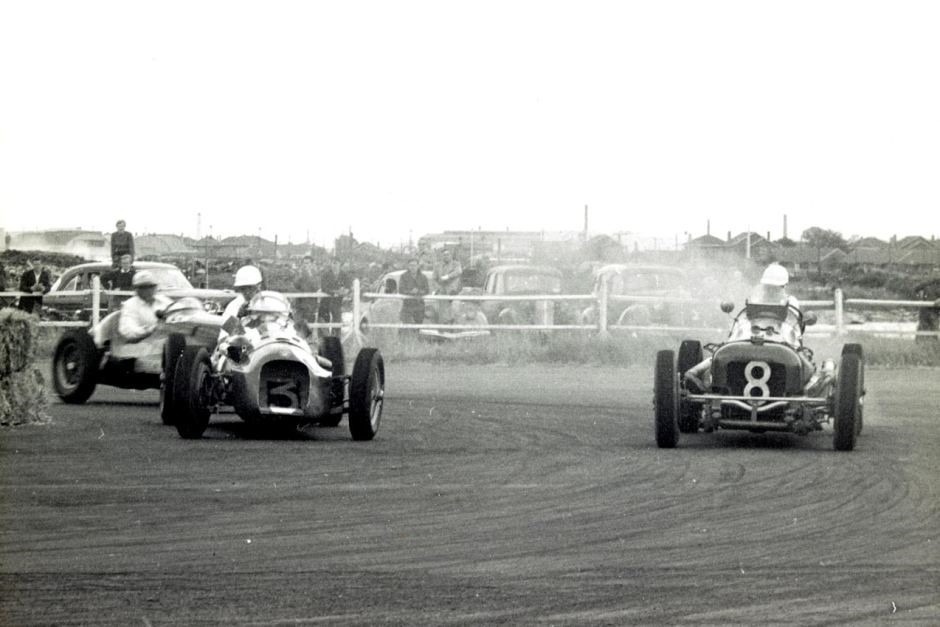
Jack Brabham (back), in a Cooper Bristol, races against LtoR Lex Davison in a H W M Jaguar and Ted Gray in an Alta Ford race for the Victoria Trophy at Fisherman's Bend, Victoria, on March 22, 1954.
During this time, he picked up the nickname "Black Jack", which has been variously attributed to his dark hair and stubble, to his "ruthless" approach on the track.
Having seen that he could be competitive with some of the best international racers, in 1955 Brabham headed off to England, financing the trip by selling virtually every piece of motor racing hardware he owned. He later regretted selling his lathe and other workshop machinery. Once in Europe, he sent a letter of introduction to Maserati and Ferrari and went by train to Moderna, first the Maserati factory and then to Ferrari. Ferrari turned him down. Jack will later say: "Ferrari later turned me down and I had great pleasure in beating them."
Brabham briefly and unsuccessfully campaigned his own private second hand Formula One Maserati 250F during 1956, but his season was saved by drives for Cooper insports cars and Formula Two, the junior category to Formula One.
There he raced a Cooper-Alta without much success. It was not until he switched to a Bristol engine that thing begun to improve and he was soon working at the Cooper Car Company in Surbiton where in lieu of payment, he was allowed to build a car which he raced and then sold. Back in the late 1950s, the UK and Europe were the global centers of motor sport; they probably still are. Arrivals from the colonies were viewed with some amusement and, tolerated. When Jack arrived at the Cooper Car Company to take up their offer of a car, he was shown a pile of tubes in a rack and told to start building, and before too long, the Coopers understood what they had on hands. He made his Grand Prix debut at the age of 29 driving the car at the 1955 British Grand Prix with Bobtail mid-engined sports car, intended for Formula One. It had a 2-litre engine, half a liter less than permitted and ran slowly with a broken clutch before retiring. Jack also competed in the US at Indianapolis, qualifying the first modern mid-engined car at the 500 and finished ninth.
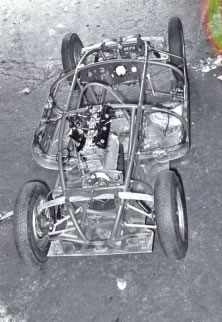
Bobtail - Cooper - Bristol without panels prepared for British GP 1955. Note the chassis.
Jack’s engineering knowledge helped in the development of the Coopers, the first serious rear-engined grand prix cars, with which he won his 1959 and 1960 world titles.
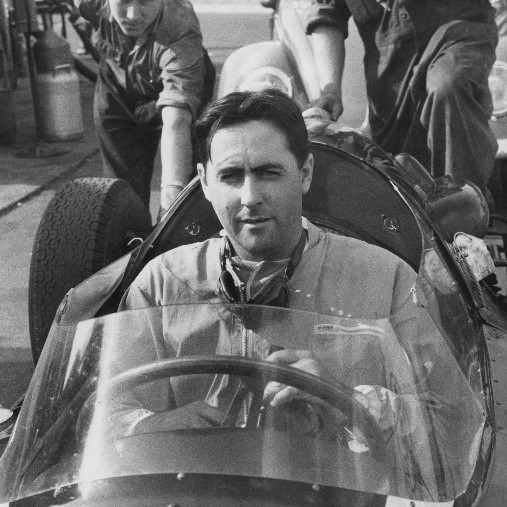
A top driver, Jack Brabham, at the German Grand Prix in 1959. Credit Robert Daley, The New York Times.
In 1959 Cooper obtained 2.5-litre Coventry Climax engine for the first time and Brabham put the extra power to good use by winning his first world championship race at the season-opening Monaco Grand Prix, after Jean Behra's Ferrari and Stirling Moss's Cooper failed. He took his first F1 crown in spectacular fashion at the United States Grand Prix, pushing his Cooper Climax across the finishing line after it ran out of fuel two corners before, to finish fourth and become Australia’s first Formula 1 World Champion. This year at the Portuguese Grand Prix at Monsanto Park, Brabham was chasing race leader Moss when a backmarker moved over on him and launched the Cooper into the air. The airborne car hit a telegraph pole, throwing Brabham onto the track, where he narrowly avoided being hit by one of his teammates but escaped with no serious injury. On the end, Brabham won the World Championship. In 1960 he repeated this feat with a new low-line model, which included a streak of five straight victories. Brabham helped design the more advanced, low-line Cooper T53, including advice from Tauranac. Brabham spun the new car out of the next championship race, the Monaco Grand Prix, but then embarked on a series of five straight victories. He won from the front at the Dutch, French and Belgian Grands Prix, where title rival Moss was badly injured in a practice accident that put him out for two months. Two other drivers were killed during the race.
Unable to have greater input in car building, he went out on his own, forming Motor Racing Developments Ltd. (MRD) in 1961, in partnership with an old friend from Australia, Ron Tauranac. MRD initially produced cars for Formula Junior, with the first one appearing in mid-1961.
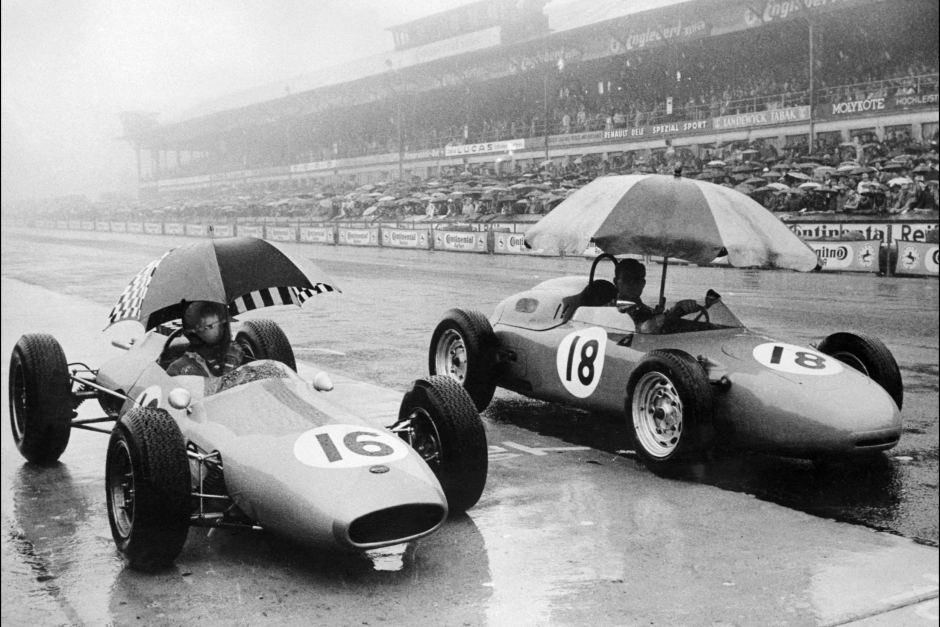
Jack Brabham (L) waits for the start of the German Grand Prix alongside Count Carel Godin de Beaufort at the Nurburgring race track in 1962.
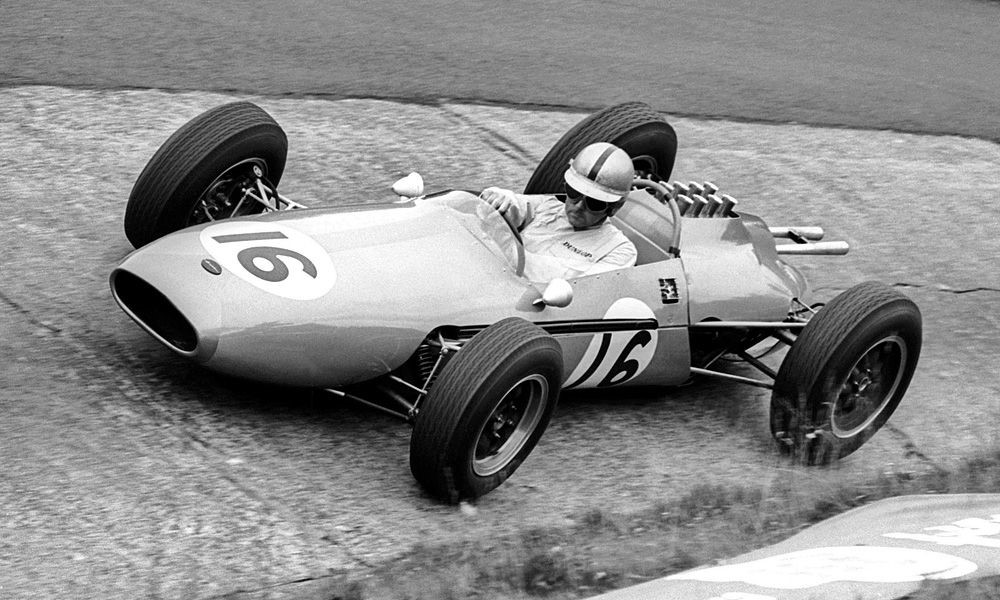
Brabham BT1 at Nurburgring in 1962.
Soon, Jack and Brabham cars were competing in what was then the 1.5 liter Formula One.
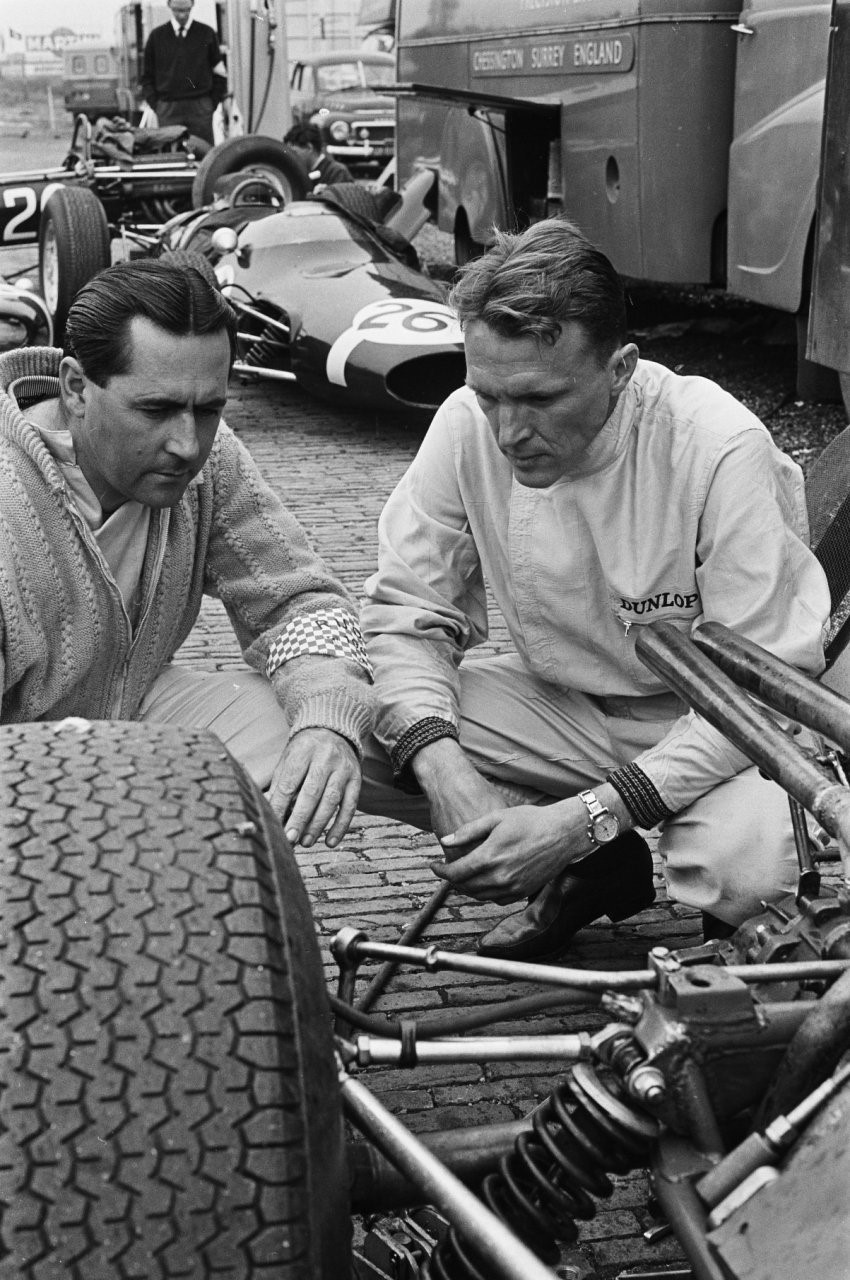
Gurney and Brabham at 1964 Dutch Grand Prix.
A newly introduced engine limit in Formula One of 1500 cc did not suit Brabham and he did not win a single race with a 1500 cc car. It was left to American Dan Gurney to take the team's maiden victory at Rouen.
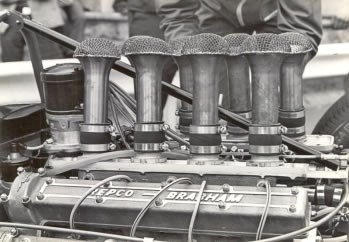
For 1966 and 1967, Repco and Brabham had been on top of the world.
For 1966 a new 3 liter formula came into existence.
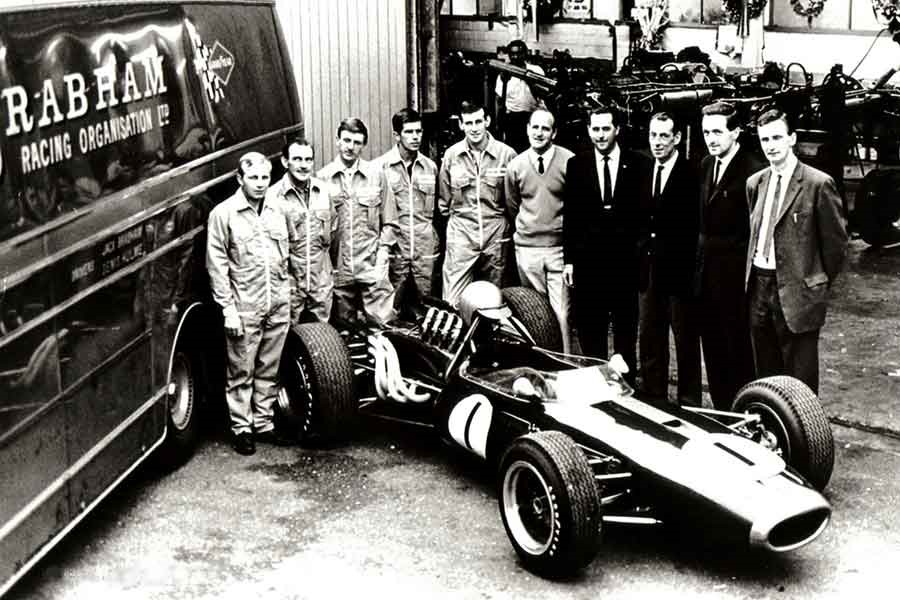
Brabham team in 1966.
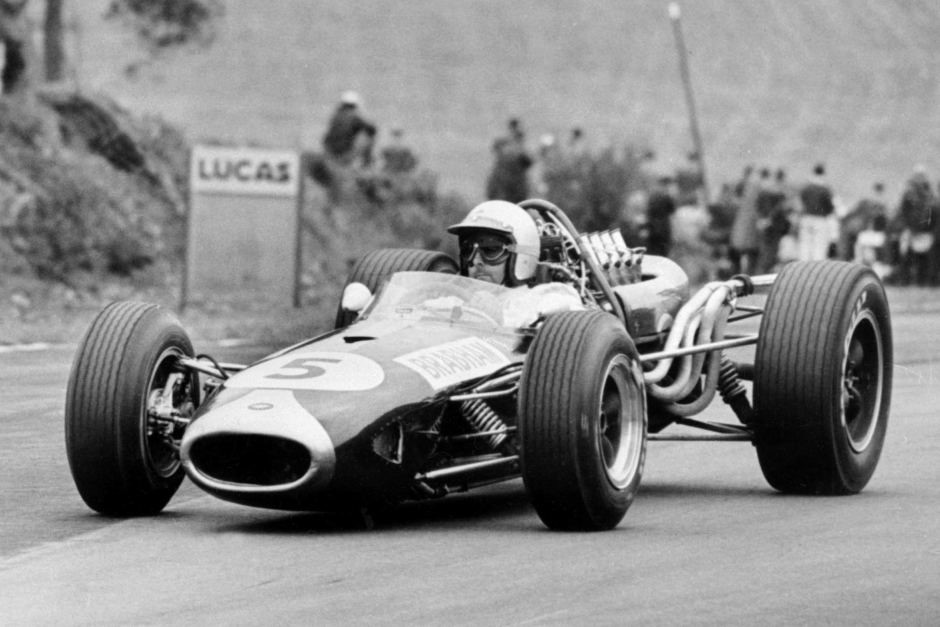
Jack Brabham drives in the British Grand Prix at Silverstone, July, 1966.
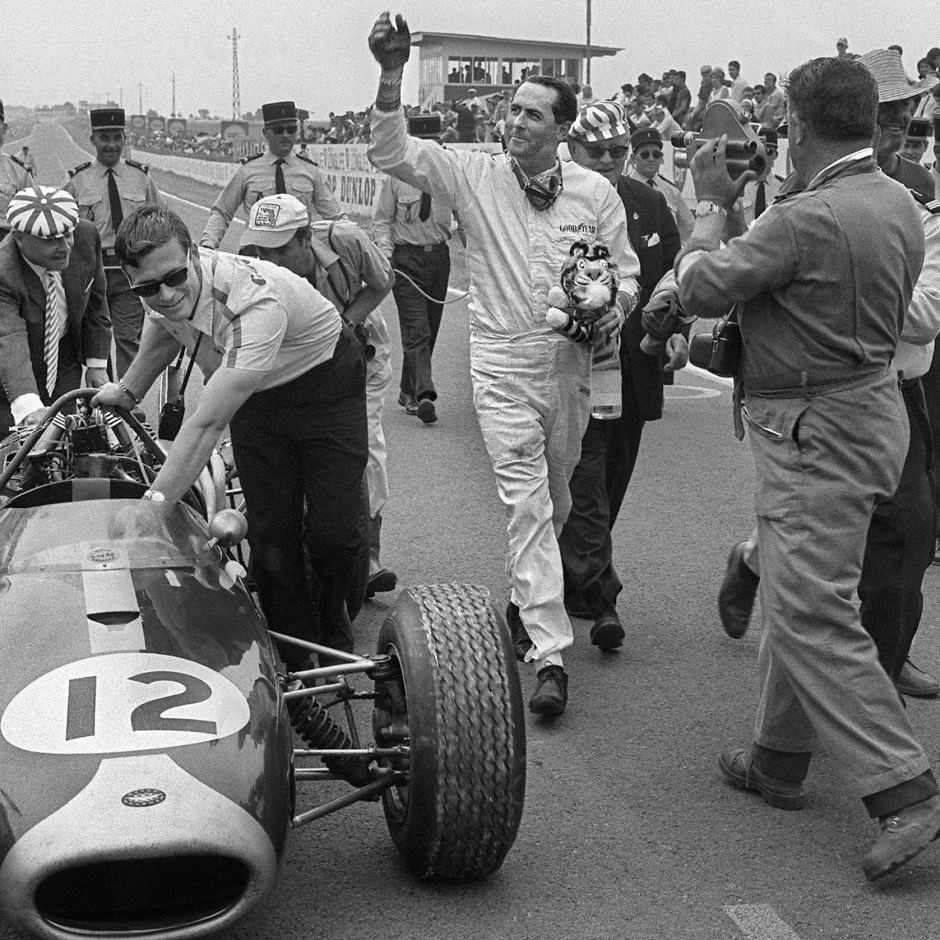
Jack Brabham waves to the crowd after winning the French Grand Prix in July, 1966.
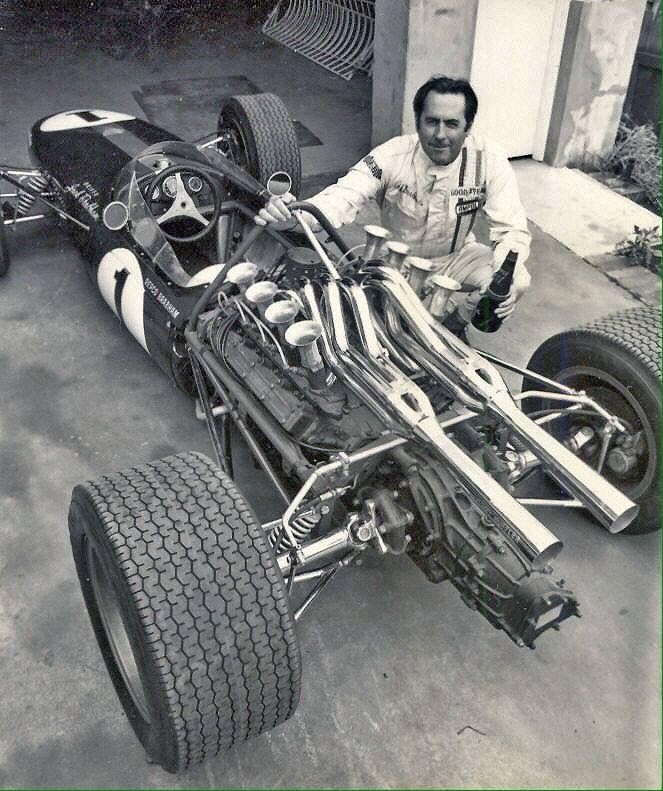
Jack Brabham, 1966 World Champion.
With the traditional engine companies all talking big V12 powerhouses, Jack reasoned that they’d probably have a hell of a time getting them sorted and reliable. In the meantime, something a little smaller and reliable might just do the trick. Brabham found an engine in his own backyard, he persuaded Australian engineering company Repco to develop a new 3-litre eight-cylinder engine for him. "When Leonard Lee announced that his Coventry Climax company would not build racing engines for the new 3-litre F1 of 1966, we had to look elsewhere for motive power. Ron (Tauranac) and I contacted Repco in Australia. I believed the new Formula's opening races would see the big teams in development trouble with over-sophisticated new engines. Repco of Melbourne had taken over the old Climax 4-cylinder FPF engine stock and its servicing for Tasman racing. By 1964-1965 they were keen to defend their market with a replacement engine. I pointed them towards a V8, perhaps based on a production cylinder block. A cast-iron "stock block" would have been too heavy so I hunted down a suitable aluminium one."
From that thought came the relationship with Repco and a ground-up V8 engine designed and built in Australia. Repco had no experience in designing complete engines and Brabham had find a supply of suitable engine blocks obtained from Oldsmobile's twin-cam F85 light-alloy block engine and persuaded the company that an engine could be designed around the block, largely using existing components. It was light and reliable, not as powerful as some of the ferocious V12s would be, but it was just the right thing at the right time. About finding the right engine block supply Jack was righting: "in Japan in 1964, I inspected an alloy V8 Prince block - but with wet cylinder liners it looked too fragile. I then examined an alloy GM Buick block in a GM distributorship near Los Angeles Airport. Someone there suggested a near-sister unit, developed for a stillborn Oldsmobile project. It had one extra stud retaining each cylinder head. That offered greater potential. One cost pennies and I took it back to Melbourne and outlined a program to Repco's boss, Charles McGrath. The Oldsmobile block could provide a 2-1/2-litre V8 for Tasman racing and a 3-litre F1 V8 for us. It'd be a modest unit with chain-driven single overhead camshafts and two valves per cylinder but it should provide decent torque and drivability - we might just get lucky! Repco's consulting engineer was Phil Irving - an Australian of enormous experience, particularly with Phil Vincent on his world-famous motorcycles. Phil began drawing in Australia, and then came to Britain for 1965 taking a flat near Croydon where we spent hours in the evenings looking over his shoulder as he drew the first engine. Ron advised on location of ancillaries etc so this new V8 would fit our cars ideally. The first Repco V8 racing engines used original Oldsmobile blocks modified in Melbourne. We stiffened the bottom end with a steel plate with apertures allowing the con-rods to pass through and to which the big-end bearing caps were bolted. It produced a rigid, reliable, yet lightweight unit which was powerful enough!"
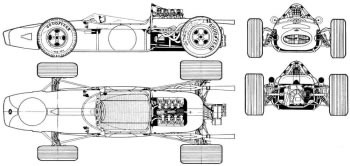
The combination of the Repco engine and the Brabham BT19 chassis designed by Tauranac worked. The Repco-Brabham would provide Brabham a car with which he won the French, British, Dutch and German Grands Prix and that year World Championship. Jack stated that the BT19 was "beautifully balanced" and he loved its readiness to "drift" through fast curves. Jack Brabham took his first Formula One world championship win since 1960 and became the first man to win championship in a car of his own construction. Only his two former team mates, Bruce McLaren (Belgium GP in 1968, McLaren-Ford) and Dan Gurney (1967 Belgian Grand Prix, Eagle-Weslake), have win the race in a car of his own construction. The unthinkable had been achieved – a driver from Australia had not only won his third world title, this one was in a car he’d built himself. Imagine the logistics alone – engines being built on the opposite side of the world and flown backwards and forwards during development.
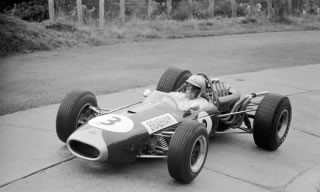
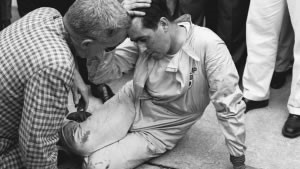
1966 Nurburgring, Germany, "the most satisfying" victory. On the top during the race and exhausted after the race.
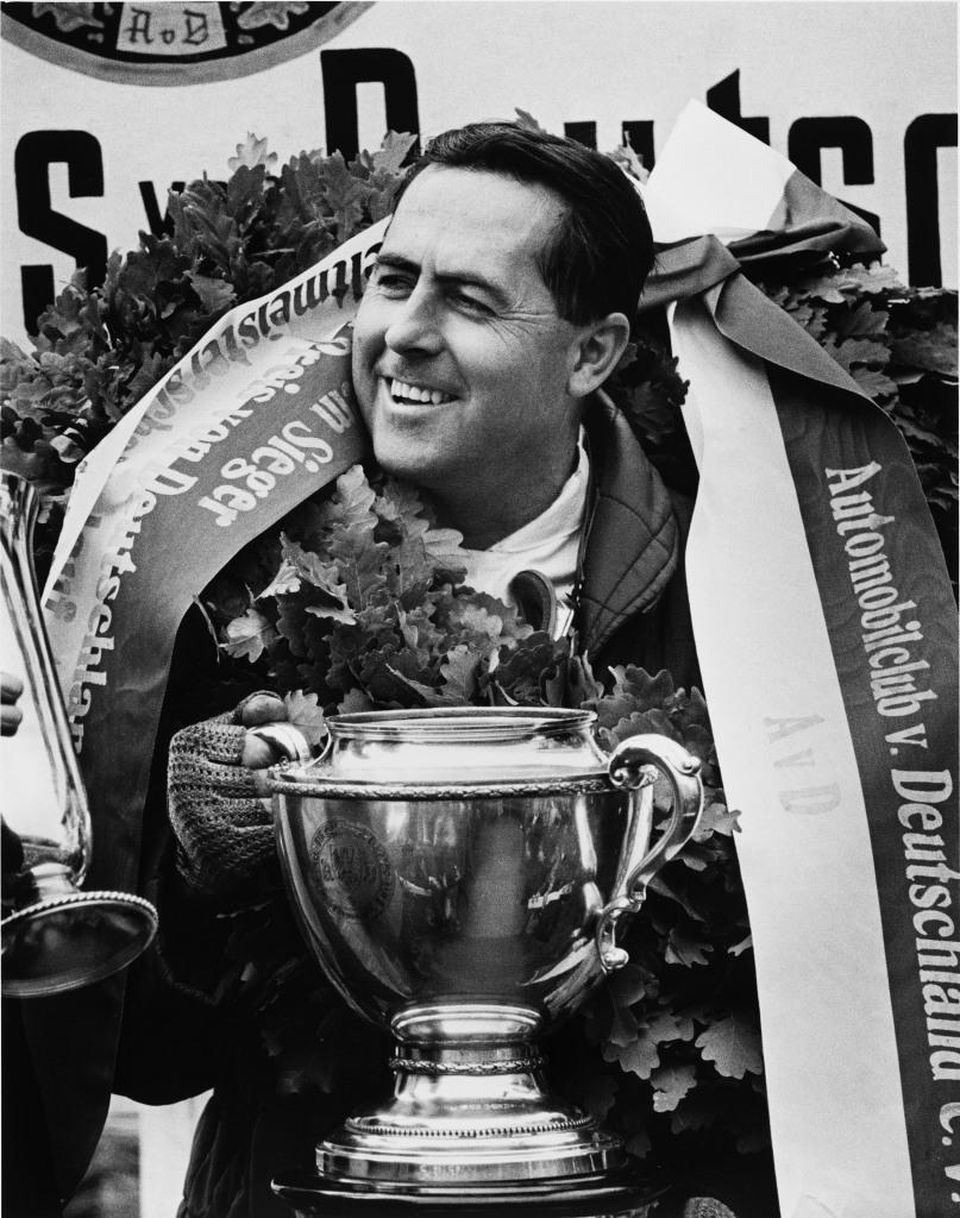
Jack Brabham, in a Brabham BT19, winner at Nurburgring on 7 August 1966. Images forbes.com Guy Martin files 2019-06.
Perhaps his most famous race was at the extremely demanding Nürburgring and one of his most satisfying of victories in 1966. Conditions at Nurburgring were variable all round the 14-mile (20-km) circuit. Some sections were almost dry, others merely wet and several "absolutely swimming", he commented.
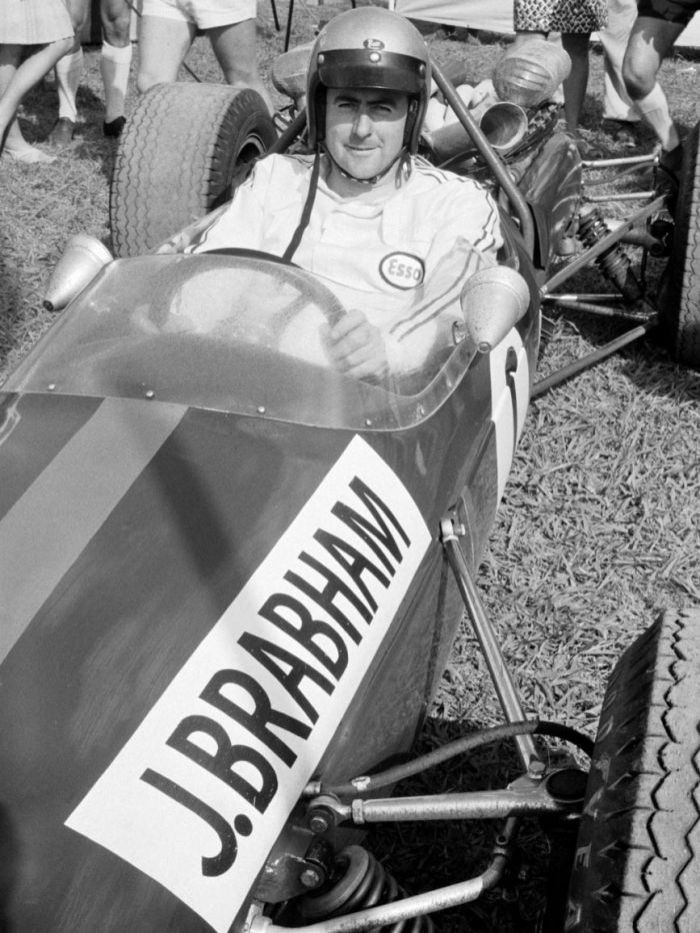
Jack Brabham sits in his car at the Warwick Farm racing circuit near Sydney in 1967.
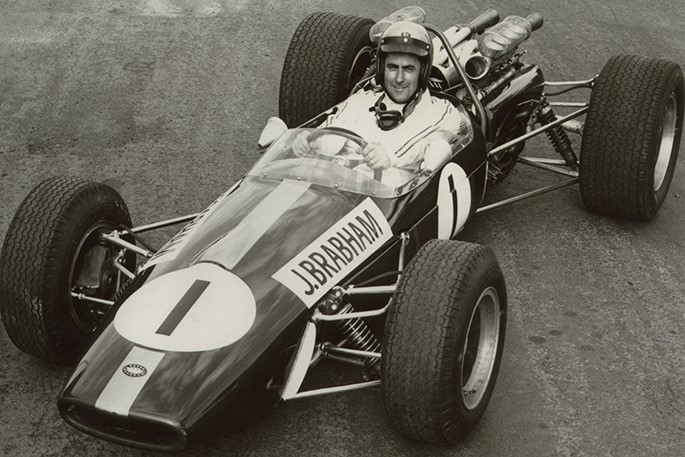
Sir Jack Brabham at the wheel of the 1967 Repco-Brabham BT23-A-1.
The next year, 1968 season, would follow with another championship for the team, this time the title went to his teammate Denis Hulme. Jack suffered from the unreliability that comes with trying new things ‘on the run’. He retired from the first seven races, before scoring two points for fifth place at the German Grand Prix. He retired from the remaining four races. Eventually, the rest – particularly with the arrival of the brilliant Ford Cosworth engine – caught up and the Repco program came to its end. Brabham’s cars switched to the ubiquitous Ford and remained among the most competitive cars for some years. 1968 belonged to Lotus and Ford-Cosworth, despite the tragic death of Jimmy Clark.
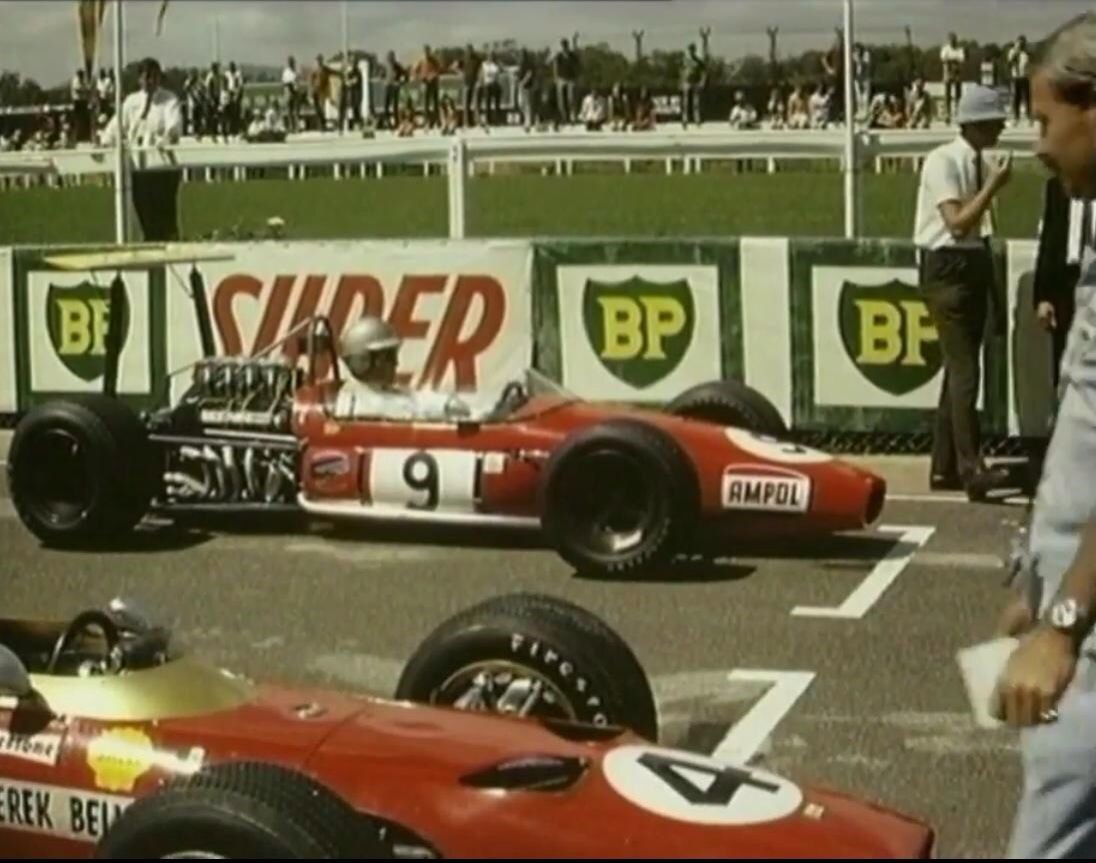
1969 Brabham BT31.
For 1969 Jack Brabham also had a Ford-Cosworth engine deal but a broken ankle during a test crash ruined his title chances.
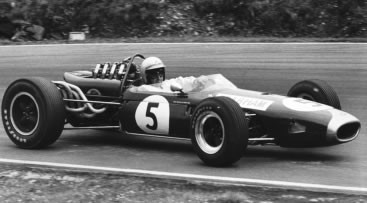
Following serious injuries to his foot in a testing accident in the 1969 season and under pressure from his wife, Brabham intended to retire in 1970 but he find impossible to hire top driver, he raced for one more year. Rather than going through the motions, he won the season opener at the South African Grand Prix and led the always difficult Monaco Grand Prix until the final corner of the last lap while under pressure of the onrushing Jochen Rindt. The Mexican Grand Prix would be his last race but even at 44 his fires still burned strong.
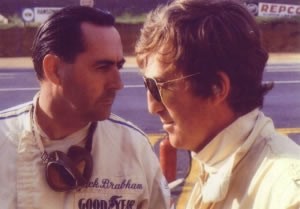
Jack Brabham and Jochen Rindt in 1968, big friends.
But, during the qualifying for the Italian Grand Prix, Jochen Rindt was killed in a needless crash driving a Lotus. This time Jack listened to his wife and, at the end of the year, hung up his white and gold helmet and walked away. After retiring from driving he sold his interest in the team to his partner Ron Tauranac and returned to his native Australia to live on a farm and set up garage and car businesses, to the relief of his wife who had been "scared stiff" each time he drove. Later in his life Brabham would regret making such a clean break from Formula One. In an interview to Motor Sport Jack say: "I felt very sad, [...] I didn't feel I was giving up racing because I couldn't do the job. I felt I was just as competitive then as at any other time and I really should have won the championship in 1970. [...] I'd have been a lot better off if I'd stayed, but sometimes family pressures don't allow you to make the decisions you'd like to."
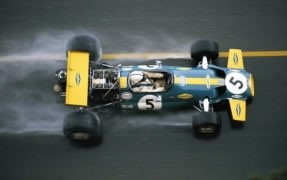
Brabham's last Formula 1 race car.
Besides maintaining his garage business he still makes appearances at the various vintage races that seem to be springing up everywhere. Despite a large accident at the 2000 Revival, the first racing accident to put him in hospital overnight, he continued to drive until at least 2004. He also set up Engine Developments Ltd. (originally marketed as Jack Brabham Conversions) in 1971 with former Repco engineer John Judd, who had worked for Brabham on the Repco engine project in the mid 1960s. The company builds engines for many racing applications.
The Brabham team continued in Formula One, winning two further drivers' championships in the early 1980s under Bernie Ecclestone's ownership. Although the original organization went into administration in 1992, the name was attached to a German company selling cars and accessories in 2008 and an unsuccessful attempt to set up a new Formula One team the following year. On both occasions the Brabham family, which was not interested in the ventures, announced its intention to take legal advice. Brabham is a shareholder in Jack Brabham Engines Pty Ltd., an Australian company marketing Jack Brabham memorabilia.
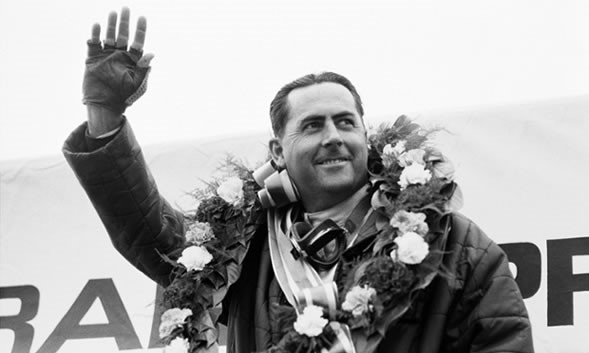
Brabham was the first post-war racing driver to be knighted when he received the honor in 1978 for services to motorsport.
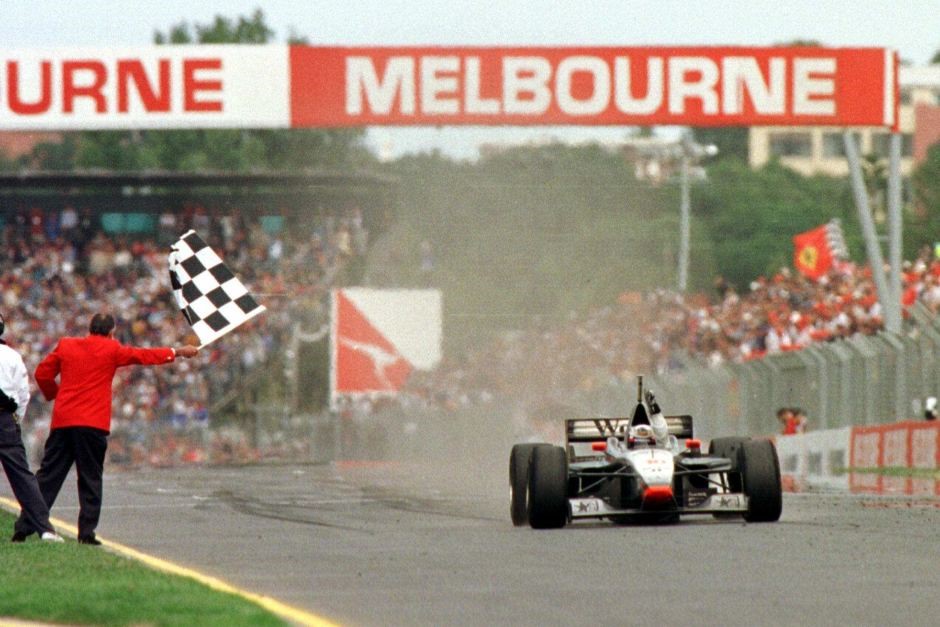
Sir Jack Brabham waves the chequered flag as David Coulthard in a McLaren crosses the finish line to win the Australian Grand Prix in Melbourne in March, 1997.
By the late 2000s, ill-health was preventing him from driving in competition. In addition to the deafness caused by years of motor racing, his eyesight was reduced due to macular degeneration and he has kidney disease for which, by 2009, he was receiving dialysis three times a week.
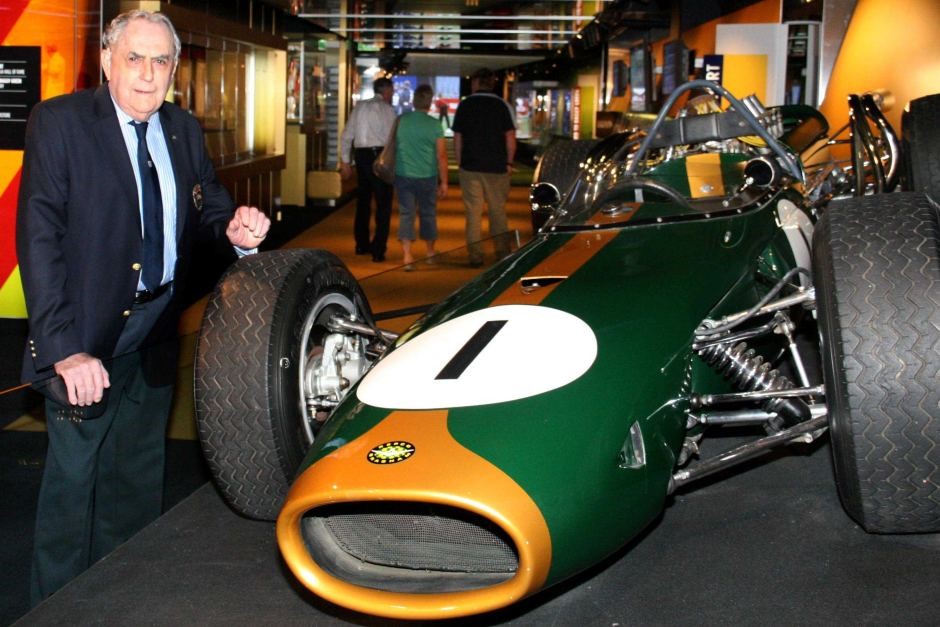
Sir Jack Brabham stands next to his Repco Brabham BT19 when it was on display at the National Sport Museum at the MCG, January 2010.
Nonetheless, that year he attended a celebration of the 50th anniversary of his first world championship at the Phillip Island Classic festival of motorsport and, in 2010, flew to Bahrain with most of the other surviving Formula One world drivers' champions for a celebration of 60 years of the Formula One world championship. Brabham was the oldest surviving F1 champion.
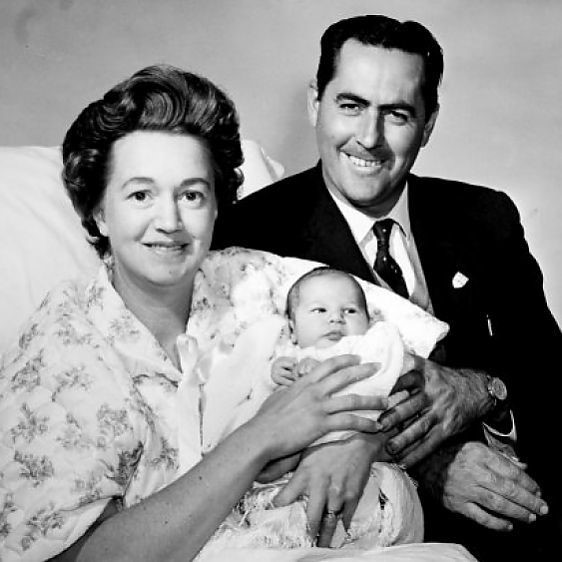
Jack and Betty Brabham.
Brabham and his first wife Betty had three sons together: Geoff, Gary and David. All three became involved in motorsport with varying degrees of success, with support from Jack in their early years. Jack and Betty divorced in 1994 after 43 years. In 1995 he married his second wife, Lady Margaret and they lived on the Gold Coast, Queensland, Australia. Brabham made his last public appearance on 18 May 2014, appearing with one of the cars he built. In Australia he was one of the greatest sporting legends, while in the wider world he was one of the few whose name became synonymous with the sport.
Given the enormity of the modern Formula One, Jack’s achievement – winning in a car bearing his own name (and with an Australian-built engine) – simply cannot be repeated. He owns a unique spot in motor sport history and Australia should be very, very proud. He lived an incredible life, achieving more than anyone would ever dream of and he will continue to live on through the astounding legacy he leaves behind. He was one of only 4 Australians to win Formula 1 race. He won 14 between 1959 (the year he won the first of his three world championships) and 1970. Alan Jones, the 1980 world champion, won 12 GPs between 1977 and 1981, Mark Webber won nine between 2009 and 2012 and 2014 in Canada was first win of Red Bull rocky Daniel Ricciardo.
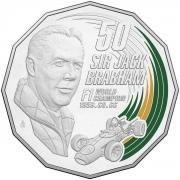
To show appreciation to Australia's most successful racing driver, country recognised all this through a commemorative 50cent coin by an iconic national institution, the Royal Australian Mint. The Coloured 50c uncirculated coin serves to pay tribute to his legacy of achievements and will be a collectors item among motorsport fans around the world and coin collectors alike. Just 30,000 coins will be minted and are available from the Royal Australian Mint for $23.50, including receipted delivery.
Videos


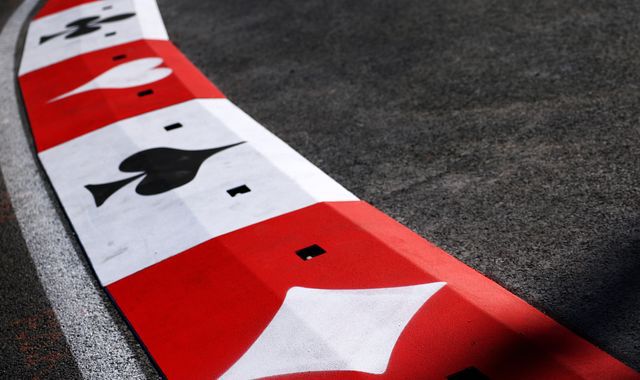
Comments
Authorize to comment